| Acton Sub | 21 x 26 | The Acton Sub is an around-the-walls, modular shelf layout set in the modern era. This Sub is located off of a Class 1 mainline in the "rust belt" and serves a number of local industries as well as an interchange with a smaller shortline company. The local GP38 provides pick up and delivery service and does a twice daily run down to the Interchange. |
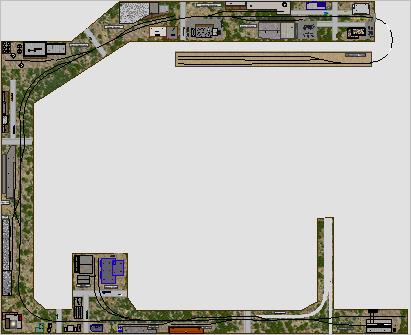 |
| Ajax Junction Revisited | 19 x 31 | The Ajax junction is an imaginary meeting point in central Pennsylvania between the PRR and the NYC in the late 1940s. Both railroads have customers in the town and work them, while they deliver cars to the interchange tracks for each other. In this expanded version, you will have more industries to service for either the NYC or the PRR and the bridge traffic has been increased |
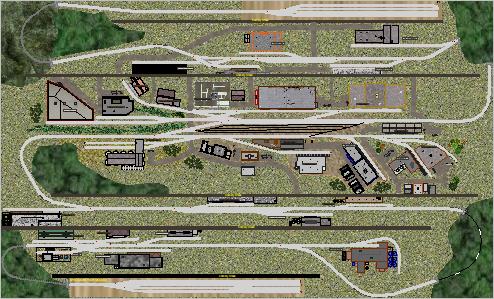 |
| Alameda Belt Line | 20 x 26 | The Alameda Belt Line [ABL] is set in the 1950s early diesel era. It depicts the port of Oakland and the industries along the harbour. The ABL was a short line specialist railroad which interchanged cars with the Southern Pacific along the south side of the plan [Oakland] and via a twice daily car float service [Alameda Basin]. Due to the restricted space of this area and its tight curves, shorter rail cars and switch engines dominated the scene. This "around the walls" plan with a peninsula was inspired by an original design by Brian Wood whose version appeared in Model Railroader in April, 1980. |
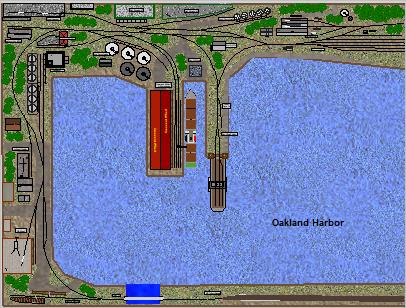 |
| Alcos in the Alcove | 10 x 16 | This is a shelf layout design from Byron Henderson which appeared in the July, 2009 issue (#3) of Model-Railroad-Hobbyist media-zine. Byron combined operating fun and modeling challenge in a 3' x 5' space. This plan is based on the Sturtevant, Wisconsin, a Milwaukee Road station which is a unique design since it served two different MILW lines at a near 90-degree crossing. It's also fairly large for a station, so Byron decided to place it at the far corner of the alcove shelf. This allowed him to provide just the suggestion of a crossing line without using much space. Since he wanted more of a granger theme, he included an ADM Grain Elevator, a County Co-Op along with a small manufacturing plant - A.C. Brown Manufacturing. |
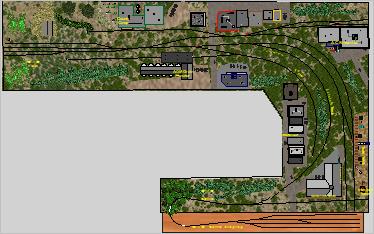 |
| Anchor Bridge Route | 17 x 34 | Anchor Bridge Route [ABR] supplies an important link for two shortlines - East Dorset Rail and Westland Rail. The rail traffic from the 2 short lines originates in the 2 staging areas on the plan but Anchor Bay has track rights for each yard. The ABR provides service to its on-line customers while moving the freight for its larger regional carriers. The ABR has a stable of 4 SW1 workhorse diesels, 1 of which is housed in the ABR Engine Depot on the north side of the plan. |
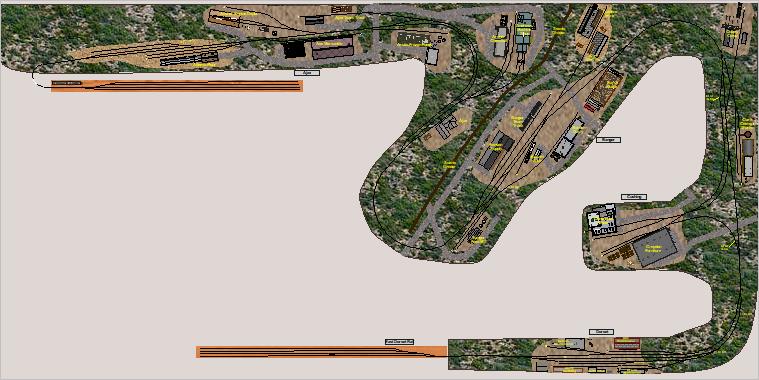 |
Angleton 1966 |
16 x 22 | Angleton is a busy industrial district on the C&O line near a medium sized MidWest urban centre. It has an industry yard which receives a daily intake of new cars from the main line road engines. Angleton has a modest C&O transload centre and a small grain mill which are Hotshots with "blocks" of cars destined for each site. Once these are dealt with, the SW1200s can work their morning and afternoon jobs based around a mix of industries including a Sylvania Electric, a Ford Motor Co engine plant, International Paper and a food processor. |
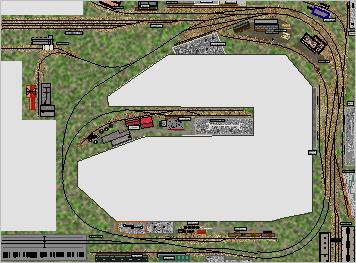 |
| Assegai Kop | 5 x 12 | The railhead at Assegai Kop is the interchange for dispatching copper ore mined on the Kop to Port Elizabeth. All trains climbing the Kop must use an articulated engine. Short trains are the norm and you may need to run more than one train to complete your switchlist. The term Kop in Afrikaans means a Terraced Hill or a Peak, the Boers named Assegai Kop after the short throwing spear used by Zulu Warriors. |
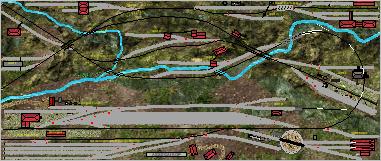 |
Astoria Branch |
13 x 19 | The Astoria Branch is a room sized plan with a focus on switching. It is based on an active but small short line operating in the US Pacific north west in the early 1950s. There are a mixture of small and medium industries and one mid sized flour mill to service twice daily. There are a couple of runaround tracks. Use them wisely and your switching will go very smoothly. |
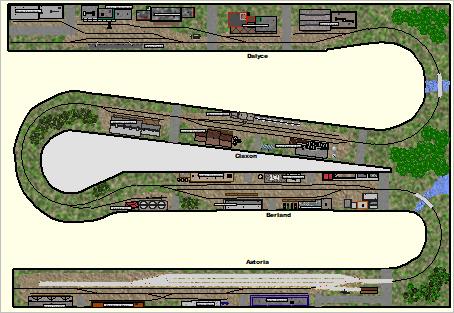 |
| Astoria City | 12 x 23 | Astoria is a typical American, small, industrial city which has a few light manufacturing plants, a brewery, a dairy, a chemical plant and some produce vendors and a good number of warehouses; all of which are still rail served. The time period on the layout is the late 1960s. A worn SW 1200 provides the motive power and runs a thrice weekly journey through this zone. Astoria is a point-to-point modular shelf layout which takes up a whole room when assembled. |
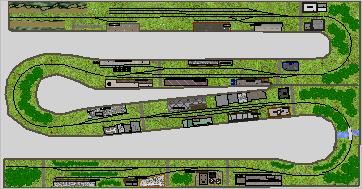 |
| 9 x 35 | This revised layout is based on the Aroostook Valley RR [AVRR] which first appeared in Model Railroader in Aug. 2013. The AVRR was a small short line railroad which operated in northern Maine and serviced several natural resources based industries including a pulp & paper mill, a food processor, potatoes, woodchips, building supplies and a dairy. The AVRR interchanged traffic with the Canadian Pacific and the Bangor Aroostook RR on a daily basis. The principal towns were Presque Isle where the AVRR's 3 - 44 ton diesels were housed and Washburn. By the mid-1940s, passenger service had ceased and was replaced with cars. |
 |
|
| Baker Sub | 18 x 34 | The Baker Sub is a room sized layout depicting a small north-eastern subdivision of a major class 1 railroad in the 1920s. There are a couple of branches which stretch out from the hub at Baker. Each town has a few mixed industries to service. Runarounds are limited so plan your trips carefully. There is a limited passenger run to the main towns. The Staging Yard on the north side of the layout, is the origin and destination for many of the raw materials which are needed by the local industries to produce their finished goods which, in turn, are shipped to far away markets via the Staging area. |
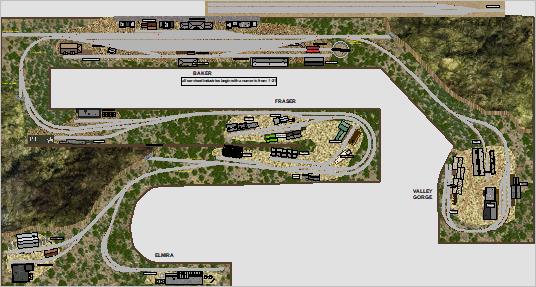 |
| Bancroft Branch | 15 x 15 | The fictional Bancroft Branch is part of the NYC railroad in upper New York state. The time period is the mid-1950s era for this room sized layout. Bancroft has several good sized light manufacturing industries which demand regular rail service. The branch is served by an SW9 switch engine. It provides thrice daily connections to all the city's businesses and it also works the interchange with the Penn Central RR which is near the end of the branch. |
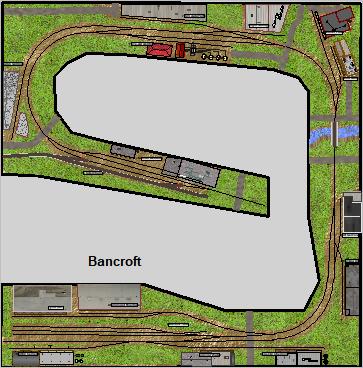 |
| Bay Street Connecting RR | 18 x 19 | This Ed Serley plan is based on a New York terminal railroad in the 1930s which received all interchanged cars via car floats. The switch engines then drag the new cars to their small classification yard on the south side, to sort for the correct warehouse or pier. All outbound cars are gathered and then returned to the storage sidings alongside the car float dock for loading later in the day. Lots of intense switching action here. |
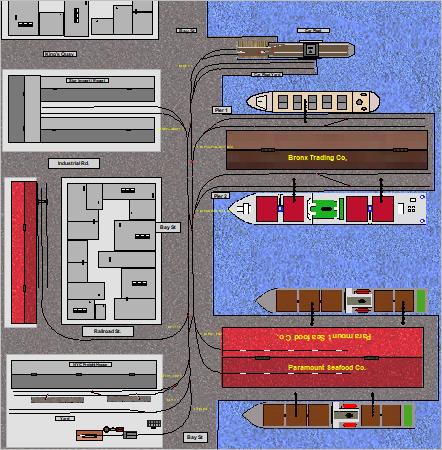 |
| Belfast Monson Line | 14 x 19 | The Belfast Monson Line is a fictional 2 foot, narrow gauge rail line running between these two towns in Maine. The time period for this room sized plan is the 1890s. Belfast has a nearby interchange with the standard gauge BAR. It also is the more populous town and has a slate polishing factory, a fresh market and a hardware maker to go along with a livestock dealer. Monson is the home of the Monson Quarry - a source of quality slate which is finished in Belfast and shipped out via the BAR [not worked on this plan]. Monson also has a paper mill, a lumber supplier and the Katahdin Iron works which fabricates many farm implements and other general iron products. Also, there is a daily mixed passenger service between the 2 towns which even services a couple of fruit and vegetable businesses in Medway. Due to the rough track and tight curves only Forney 0-4-4 steam engines are used. Most of the rolling stock was made in Maine, specifically to narrow gauge specifications. |
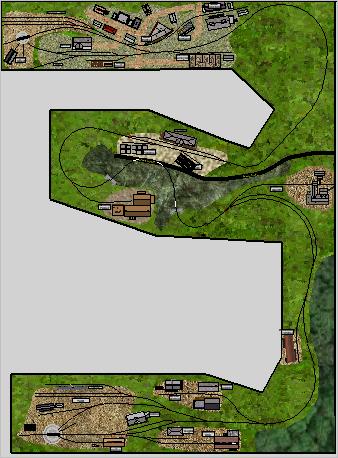 |
| Block Line | 5 x 67 | This shelf layout plan is an adaptation of Greg Johnson's Clinton Branch which appeared in the Layout Design Journal. The layout represents a portion of the busy industrial area near Vernon California in 2005. The largest area customer is the ADM Flour Mill which ships about 30 loads daily. The remaining medium-to-light industrial customers have regular but smaller traffic demands. |
 |
| Blue Mountain RR | 12 x 34 | Coal is king for the Blue Mountain RR, a room sized point-to-point plan, set in the 1920s. There are 2 major mines on this short line which generate much of its daily traffic. But due to the rugged mountain sides, trains are often double-headed when carrying a full load of black gold down to market. As well there are some smaller industries along the country side and an interchange with the PGI in the lower left corner to service. The three stations on the plan do require passenger service which is often provided via a "mixed" train. This plan is inspired by John Armstrong's Ouachita & Ozark RR. |
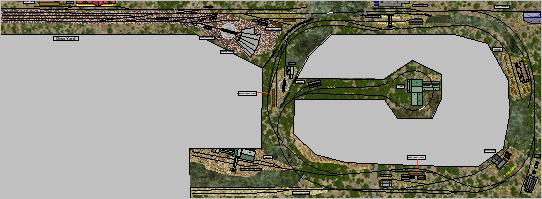 |
| Brookline | 38 x 75 | This room sized layout is based on a fictional city in the US north west in the late 1950s. There are several large heavy industries such as GE Transformers, Del Monte, and Armor Steel along with assorted small industries located in this area. There is decent sized Staging Yard at the bottom of this plan and a large UP Interchange/Staging yard on the west side as well. Also, there are 3 small yards [AY,BY,CY] to service the many industry sites. This will ensure a good flow of cars for your industries and lots of variety for your switch chores. |
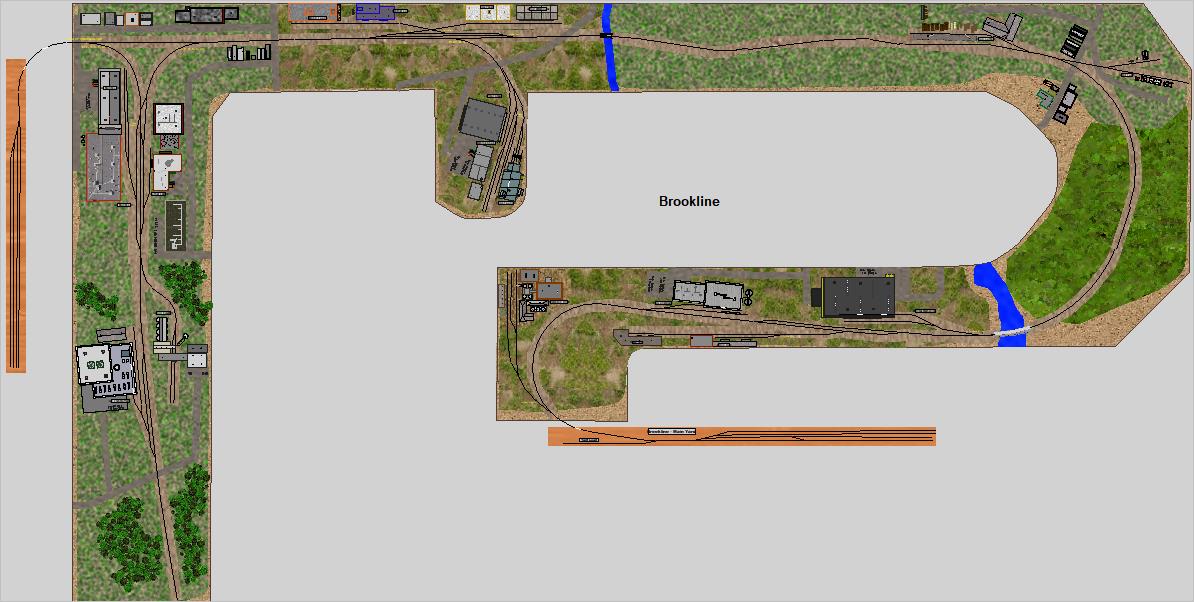 |
| Burnham IL | 12 x 24 | This room sized layout is loosely based on Burnham, Illinois in the late 1940s steam transition era. It was a mid-sized, mixed industrial city within the metro-Chicago area. The main line runs through the city and there is a network of staging tracks connecting to various local industries, including a large brewery complex. All rail traffic originates from the staging area which in turn simulates traffic both east and west bound. |
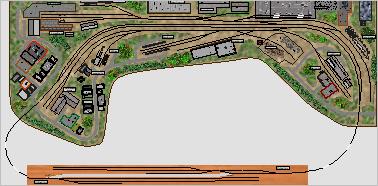 |
| Cache Valley RR | 23 x 49 | The Cache Valley Railroad is an active short line railway which is based in northern Utah. The area is known for 3 major commodities - sugar in several forms, copper and dairy products. While the various mills, mines and dairies are modest in size, they generate a lot of rail traffic. In addition, there are a few other medium light industries that also require some rail service. The Cache Valley interchanges with both BNSF and UP via the Staging Yard for connections to the American marketplace. Much of CVRR current engine roster is based on tough GE 70 ton diesels and 2 GP40s purchased from the UP. This club sized layout is set in the modern era. While many of the industry names are accurate, they are grouped rather close together here, where they are more widely spaced out in the real world. |
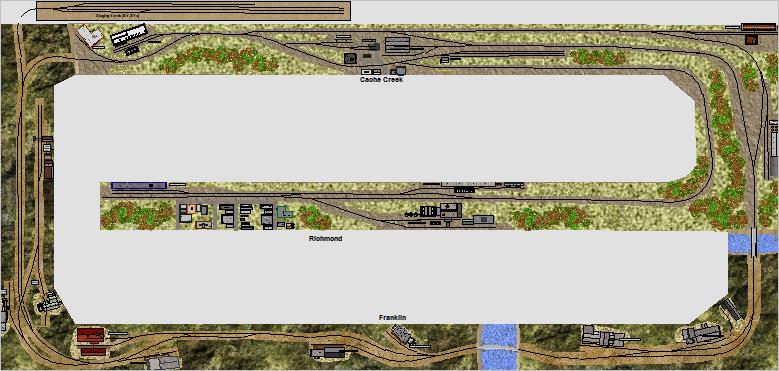 |
| California Central Traction | 32 x 38 | The prototype California Central Traction is a Class III shortline based in Stockton Ca and co-owned by the UP and BNSF both of whom interchange with the CCT daily. Those interchanges occur within either the Stockton Staging [UP] or Lodi Staging [BNSF]. The railroad operates over 300 miles of track between Stockton and Lodi. CCT serves the canning, agriculture, plastics, and winery industry in Lodi, with transload facilities in Stockton and Lodi. A significant portion of the CCT's revenue and traffic is centered around the Port Of Stockton and its nearby industrial malls. Although the CCT can trace its routes back more than 100 years, the time period modeled is the post 2000 era. |
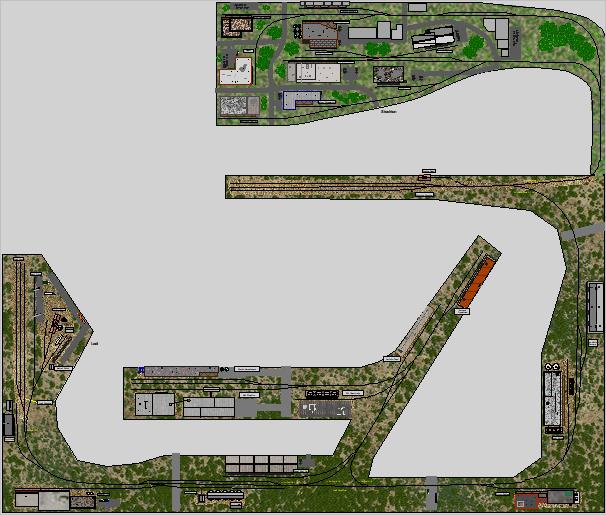 |
| California Western | 16 x 36 | California Western RR by Bruce MacLeod (02/2019) As designed this N scale layout is a 12" shelf type that runs through three 12 foot wide rooms. The real California Western is an independent short line which runs from Fort Bragg (a coastal town) to Willits in Northern California. Today it is primarily a tourist passenger line but still handles some freight. At Willits the CW connected with the Northwest Pacific (NWP RR) which currently does not operate as far as Willits. This layout harkens back to the CW's glory days of transporting loads to and from several local industries from 1940 - 1960. There is a connection to the NWP RR for transferring goods to and from the outside world. The background scenery approximates the actual scenery as it changes from coastal terrain thru pasture lands, heavy forests and then rolling, oak tree studded semi-arid grasslands. The local industries are primarily resourced based - fisheries, forestry products, and farm produce along with some light manufacturing. The CW operated a daily round trip mixed freight with minimal "unit" trains (seasonal produce, seafood, etc.) as needed. Also there was a daily round trip passenger run by the Rambler doodlebug. |
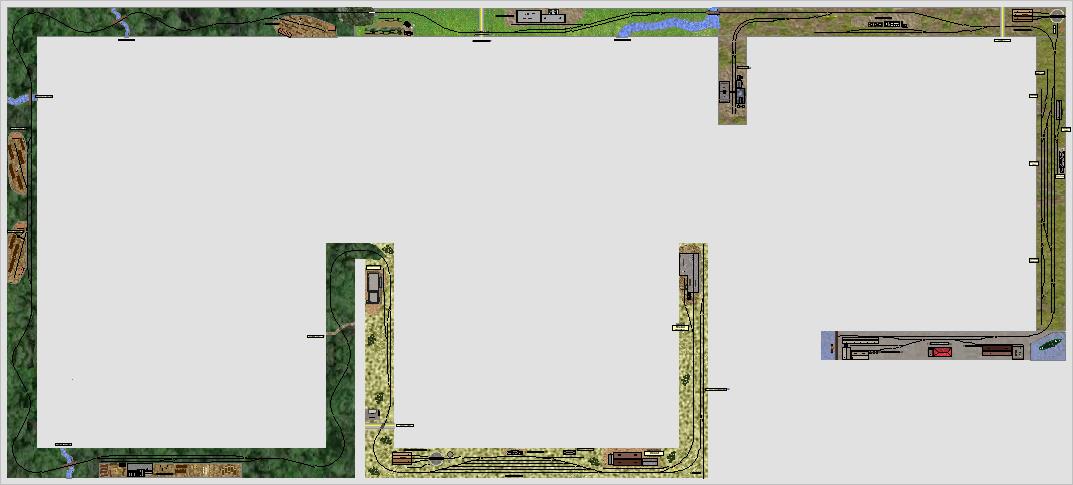 |
| Cambrian Industrial Park | 13 x 17 | The fictional Cambrian Industrial Park is located outside a major center in the Pacific Northwest in the late 1950s - early 1960s time period. It represents what a typical urban American industrial base was founded upon - solid medium sized manufacturing industries, food processing and resource based suppliers. The Cambrian Park has an active grains distributor along with a good mix of other industries. The lone GP 9 works the needs of the various industries with 3 relatively short, daily trains due to the limited runaround tracks in this area. |
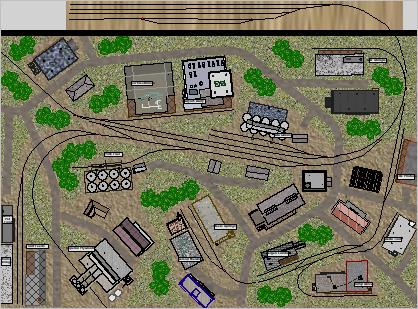 |
| Cardow Branch | 15 x 42 | The fictional Cardow Branch runs off of the New York Central Railroad's mainline in upstate New York in the early 1950s. There is still a good mix of light and medium manufacturing plants in the area and some other light industries which are based on seasonal cycles [feed mill, packing house]. As well, there is a chemical plant, a soda bottler and a canning operation, all of which require rail services. |
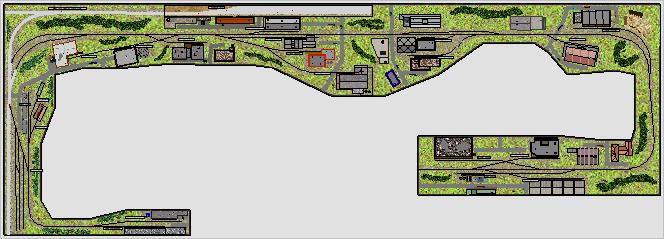 |
| Chicago Industrial | 12 x 19 | Based on and adapted from a Google roadmaps view from 2005, this layout depicts the South Woodlawn and South Dorchester Ave. industrial area in Chicago. It includes all of the actual industries which the Norfolk Southern serves in the area. We have added an interchange with the Chicago Belt Line Railway which moves cars to the many yards in the immediate Chicago metro area. |
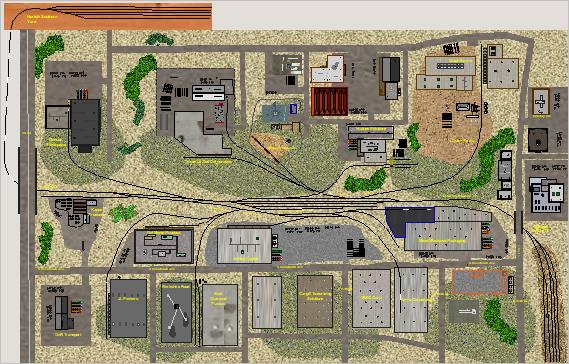 |
| Clayton | 11 x 32 | Clayton is a typical, modern mid sized city with 2 staging yards from which the local crews work to switch the various light industries and food service facilities located within its city limits. You will need to make good use of the passing sidings to complete your switch assignments |
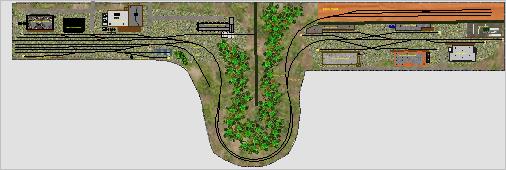 |
| CNR Port Dover | 40 x 61 | From the late 1890s until the late 1940s, Port Dover, Ontario was a thriving mixed agricultural area with a large fishery noted for its perch, smelt and cod from Lake Erie. The Newburgh Fishery was the town's largest employer and consisted of the large fish factory and related ice plant and cannery to assist in shipping their products throughout Ontario and into the US border states. Other local industries included a lumber supply firm, the Matthew Wells Pickle factory [seasonal business] and the Ivey Company, noted for its roses in particular and flowers in general [another seasonal business]. Local businesses in town shipped and received their goods either via the freight house, or for larger quantities via the Team Track. Passenger traffic even at this time, was sparse and CN serviced the area with mixed trains by adding a coach or two to a regularly scheduled freight run. |
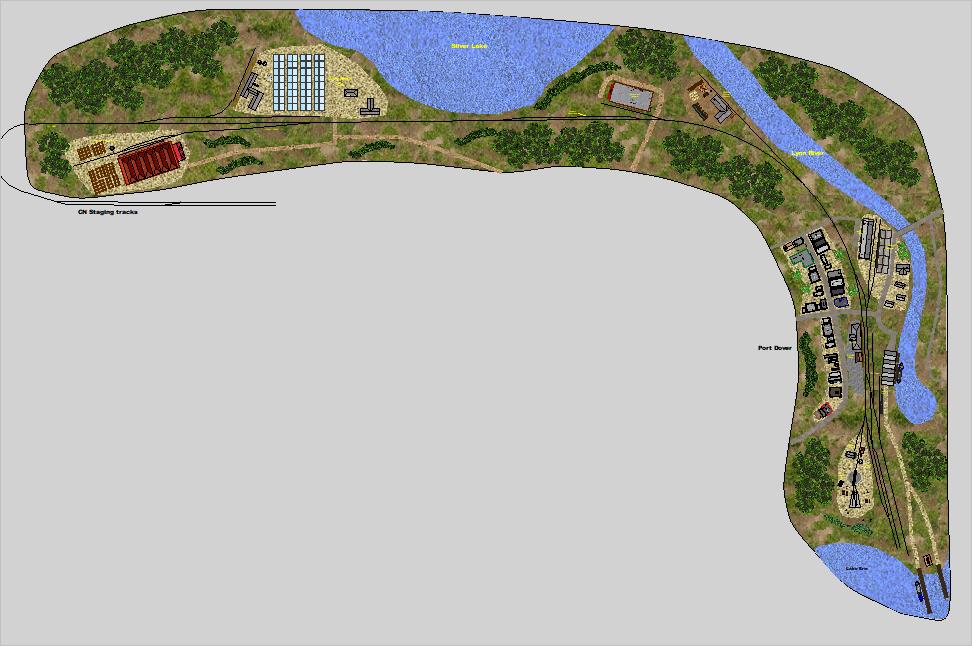 |
| Connaught | 10 x 24 | Connaught and nearby Royal are 2 mid-west cities with some interesting operations spread around several medium sized industries. This layout is set in the modern time era. Connaught has a connection with the main line for its Class 3 railway and it runs a daily express to Royal for traffic headed there. |
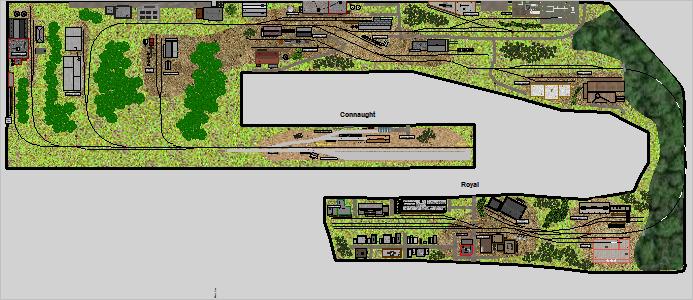 |
| Conrail's 5th Branch | 22 x 53 | This around-the-walls shelf layout represents a ficitional portion of Conrail's network in the industrial north eastern US. Set in the modern era, there are several larger industries to service along with a good deal of bridge traffic moving between centres. The main yard is located in Braddock on the south of this plan. This yard would be primarily stocked with cars destined for the industries along the branch. The Daymon yard represents the northern transfer point to the next division. |
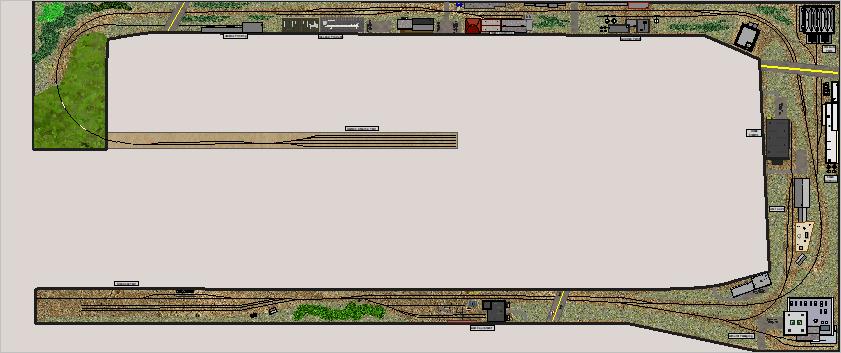 |
| CSX Mindheim Branch | 7 x 12 | This layout is basically a scenicked version of Lance Mindheim's "My Time" layout. Lance is a strong believer in the value of simplicity when it comes to model railroad design. Visit his website at www.shelflayouts.com. Your CSX Transfer switcher starts out in the Staging area and drags its cut of cars down to Mindheim Yard. From there, the SW1500 goes to work blocking and classifying the cars. It then leaves the Mindheim yard, switching industries up and down the branch until it reaches the peninsula. At that point the engine runs around the train and makes the return trip. Since runarounds are far apart, careful planning of your switching sequence is the key to success here. |
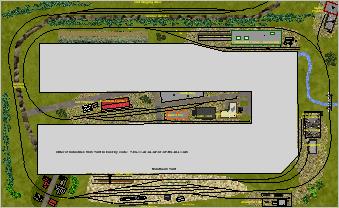 |
| CSX Pinellas Park | 18 x 32 | Pinellas Park is a city located in central Florida in close proximity to Tampa Bay. With its easy access to the Gulf of Mexico and Tampa Bay, Pinellas Park is home to many agricultural and marine businesses, from food processing to manufacturing to service and supplies. Lockheed Martin Aeronautics' Pinellas Park facility, a major employer, specializes in metal forming, fabrication and assembly of components for military and civilian aircraft. By the early 1990s, Pinellas Park had also became a centre for high tech electronics and financial services as well. This large room sized layout is an around-the-walls plan which follows the CSX mainline as it passes through the county on the way to Tampa or Clearwater. There is a decent sized yard in the eastern side of the plan and a couple of small "yard / storage" tracks nearby some of the busier industries to the south and north side of the city. A few of the industries were existing in the late 1980s time period being modeled but we have taken some liberties with most industry names. |
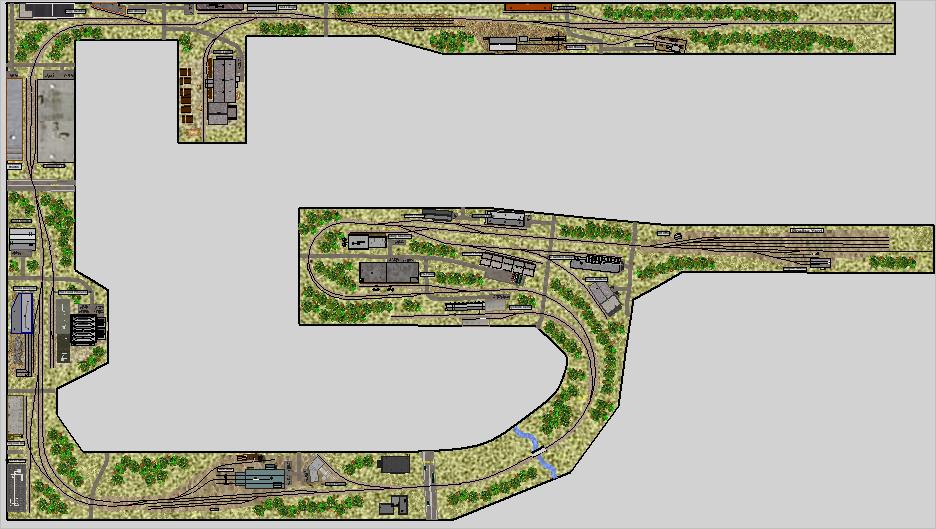 |
| Desmond | 4 x 16 | The town and yard at Desmond served a mixed industrial, agricultural and resources based branch line in the mid 1940s. The branch has 4 switching zones- (a) for the engine shed and freight house (b) for light industrial (c) mixed agricultural and industrial sites and (d) a small coal mine. There is no passenger service in this area at this time. |
 |
| Detroit Terminal Railroad 1930 | 41 x 43 | Mark Simon's Detroit Terminal Railroad [DTR] serving Detroit's East Side, is jointly owned by the Michigan Central Railroad, Grand Trunk Western Railroad and Lake Shore & Michigan Southern Railway, The DTR has additional connections with the Pere Marquette Railroad, the Wabash Railroad and the Detroit, Toledo & Ironton Railroad. It is a true bridge line. This layout reflects the Conner Creek portion of the route which had a line running east/west from Gratiot Ave to Jefferson on the shore of the Detroit River. This area included a yard facility and primarily served two auto plants,a meat packing plant and a few other modest industries. The time period modelled is the 1930s when steam was still king. There is a twice daily passenger train which stops at Conner Street station after picking up a diner car in the morning and dropping it off in the evening at Mack Ave Yard |
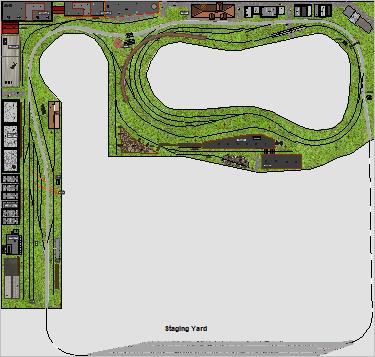 |
| Dilligence | 12 x 18 | I wouldn't be surprised if you have never heard of the Dilligence division of the British Columbia Railway. The branch serves the town of Dilligence which lies somewhere to the west of Quesnel and somehow never quite made it on to the maps of Cariboo country. The period is the early 1970's just after the BCR took over from the Pacific Great Eastern. On Mondays, Wednesdays and Fridays you operate the two car Budd RDC passenger set from Dilligence to Quesnel. Once the RDC has reached its destination you can generate a new switchlist and operate the Kettle Valley Turn from Quesnel Staging. On Tuesdays, Wednesdays and Saturdays you must return the RDC to Dilligence and generate a new switchlist for the Quesnel Turn using an engine from the shed at Dilligence. |
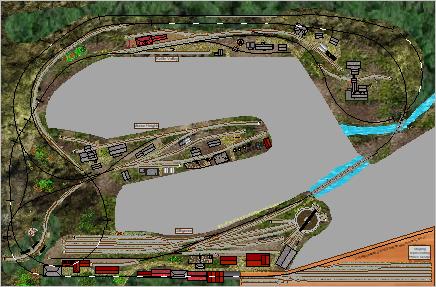 |
| District Blvd Vernon CA | 19 x 64 | This would be a room sized layout based on switching tasks which play out daily on the Los Angeles Junction [LAJ] which is a bridge short line RR linking the BNSF and the UP at Vernon CA. LAJ has two yards simply named A and B Yards. On the right side of this plan is a portion of B Yard which is where cars bound for local industries off District Blvd. are sorted and put into the correct blocks by the yard goats. |
 |
| Downtown Spur Miami | 23 x 29 | Lance Mindheim is owner of The Shelf Layouts Company, a custom model railroad building and design firm. He speaks nationally at a variety of prototype modeling conferences and is author of numerous articles for the model railroad press. An engineering graduate of Purdue University, he is a strong believer in the value of simplicity when it comes to model railroad design. Visit his website at www.shelflayouts.com. This point-to-point layout - the Downtown Spur, runs south from CSx's Hialeah Yard to service several produce centres as well as some other small to medium industries in the area. There are lots of facing point and trailing point moves to consider and just 2 runaround tracks. Plan ahead!! |
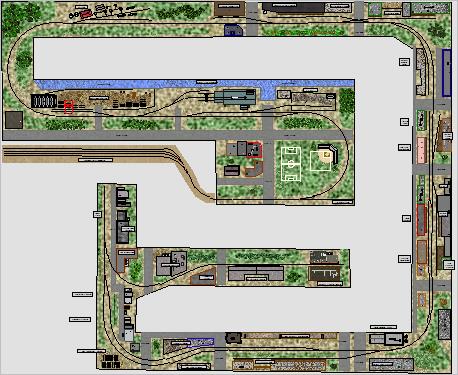 |
| Dumfries Branch | 21 x 28 | This large modular railroad focuses on a busy but fictional CN line called the Dumfries Branch. The time frame is set in the mid-1950s era. The Staging Yard serves as the entry and exit point for most of the freight traffic for area customers. But, there is as well an interchange with the Canadian Pacific RR which generates important revenue for this branch. You have a pair of SW1200 engines sitting in the off-plan divisional Staging Yard. They pull cars and service all the Branch's customers and handle all traffic via the CP Interchange connection. |
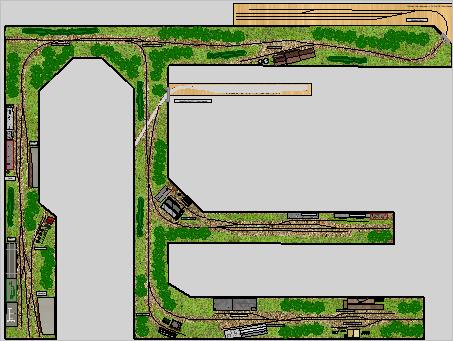 |
| Elkhart | 25 x 27 | This room sized layout is based on a fictional town set in the 1930s in north eastern Maine which is served by a 2 foot narrow gauge railway linking it to the towns of Howland and Lincoln where there is an interchange with a larger narrow gauger - the BSR railway. Elkhart is a mid-sized town with several local industries to serve. There is a mixed train for some passenger and parcel services as well as a pedlar train for special runs for the large lumber mill and stock yard and the merchants in Elkhart. Lincoln is a smaller town boasting a few rail-served local industries, along with a livestock dealer and a busy lumber / sawmill operation. |
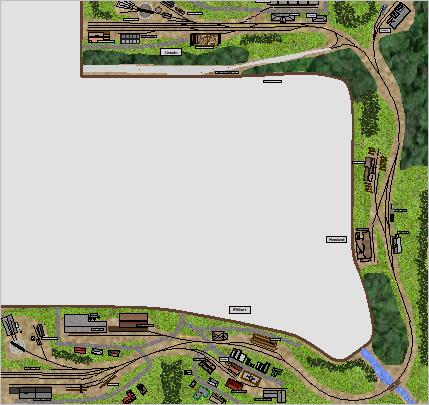 |
| Elmhurst RR | 18 x 24 | The Elmhurst Railway is a narrow gauge line which services a lumber camp and a gold mine along its rugged main line. This multi-deck plan has the natural resources located on the northern portion of this plan and the inital processors of these products are situated on the lower level. Due to rugged conditions, trains are generally short. The railway also provides mixed service using a combine to provide passenger and parcel service. |
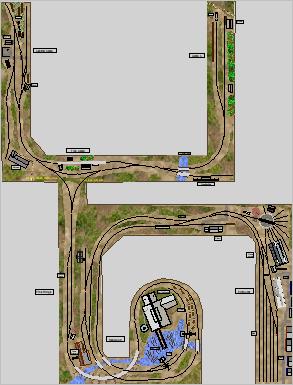 |
| Fairport | 17 x 20 | This is an adaptation of Russell Schoof's Free Haven plan which appeared in Model Railroader's 48 Top-notch Track Plans. Fairport is a busy lake harbor town, set in the early 1950s era, with its own shortline to handle the needs of local shippers and receivers. The town has four large piers to service - a large grain elevator, a bulk fuel depot, bulk goods lading and a general Pier for commercial goods. These are the main revenue generating customers for the FairPort Terminal and they all are serviced daily. The short line also has extensive freight operations for clients with less than car load requirements and a team track area for any other special loads. As well there are few other mixed industries in town which focus on light manufacturing for the martitime trades. |
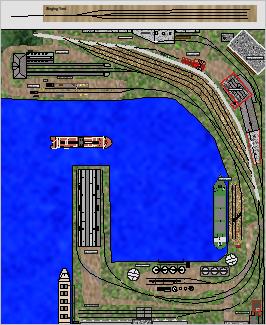 |
| Ffarquhar | 7 x 11 | Ffarquhar was the home layout of the Rev W Awdry, author of the 'Thomas the Tank Engine' series of children's books. Ffarquhar station was a removeable section which regularly toured the exhibition circuit and is currently preserved at the Narrow Gauge Railway Museum at Wharf Station on the Talyllyn Railway in Wales. To adapt the layout for TrainPlayer we have taken some liberties with the fiddle yards but the main scenic section attempts to replicate the original track arrangement. Thomas's branch line runs from Knapford to Farquhar via Elsbridge. Thomas is rostered to run three trains, starting with the Quarry Turn, this is followed by a passenger return run to Ffarquhar and finally the daily goods service. You are free to use one of the other engines if you wish. The engine should be returned to Knapford Junction for servicing at the end of each run before generating your next job. All cars displaying labels should be pulled and spotted on the tracks with the corresponding labels. |
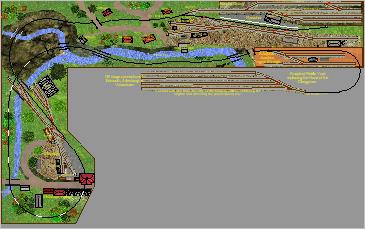 |
| Folsum Branch | 11 x 22 | The fictional Folsum Branch runs off the New York Central Railroad in the early 1960s, prior to its merger with the Pennsylvania RR. This room sized plan tries to capture the variety of industries which were served by the NYC in the Great Lakes area north of New York and Boston. There is an SW1200 assigned to look after the needs of the dozen or so small to medium light industries served along the branch. |
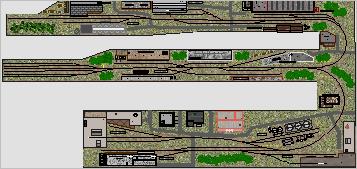 |
| Foothills Branch | 12 x 20 | This room sized layout is a conversion from an AnyRail design and was created by Bruce MacLeod [aka Mac]. The Foothills Branch is a modified version of what was the SP Kentucky House branch that ran from the junction with the SP Central Valley main line (Sacramento southerly to LA via Bakersfield) at Lodi. All of the shown industries existed except I included an extra winery, brewery and paper mill to add more work load. The usual activity consisted of a daily (except Sunday) local from Lodi Junction to Kentucky House and return. There were also small unit trains from the cement plant (large cement orders) and/or the produce house (seasonal produce shipments). I've tried to duplicate these plus adding a few special runs. |
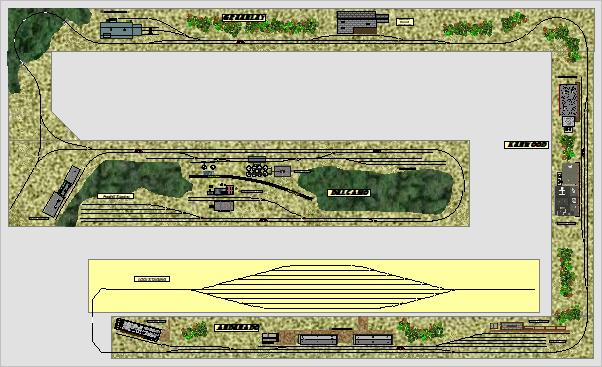 |
| Foxfield Green | 15 x 16 | Foxfield Green is a fictional branch off of British Railways. It represents a mid-sized town in south east England with a number of small and medium light industries which are still being served by rail in the late 1940s era. |
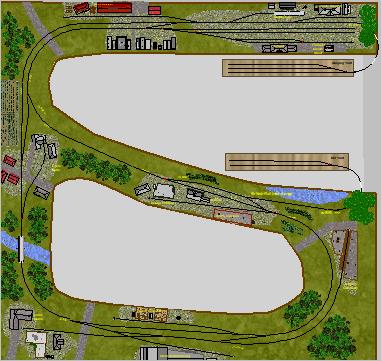 |
| Gadsby | 9 x 64 | Gadsby is a fictional mid-western US city set in the 1960s. It is strategically located between division points on a smaller Class 1 railroad. There are still plenty of rail served industries within Gadsby's city limits including a dairy, bakery factory, a flour mill, a chemical plant, an automotive plant and a mould maker. |
 |
| Galveston Wharves Terminal | 14 x 18 | Galveston Wharves Terminal is inspired by a 9 x 12 HO scale room sized plan based on a design by Cyril Durrenberger & Tom Eisenhour which appeared in MR's "101 More Track Plans for Model Railroaders". This layout set in the steam/transition era and is based on the real GWTR. This short line services the barge / float traffic and shunts cars to all the surrounding industries. |
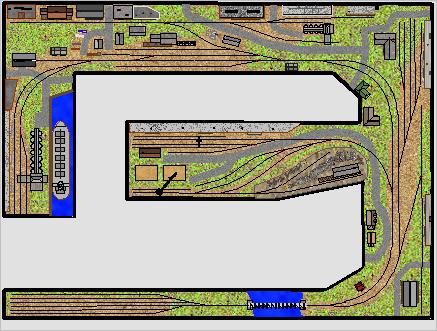 |
| D&H Garland Branch | 14 x 21 | Garland Branch is a fictional midpoint town on the D&H Railroad's Seneca Division. As such, it has only a very small yard area which also doubles as a team track spot. Garland receives/send cars both south to New York and north to Schenectady. In the late steam era depicted here, on-line industries are small light factories, warehouses and depots. |
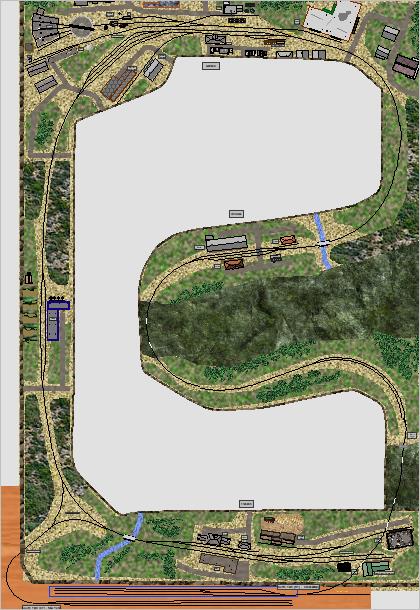 |
| Georgia Northeastern | 20 x 42 | The Georgia Northeastern Railroad is a short line freight railroad which runs from the town of Elizabeth, Georgia (now within Marietta) to the city of Blue Ridge, Georgia. Goods hauled are mostly timber, grain, poultry, and marble products. The main headquarters for the GNRR is in Marietta and its main Elizabeth Yard. The track work for this layout is inspired by Tom Klimoski's plan of the same name. |
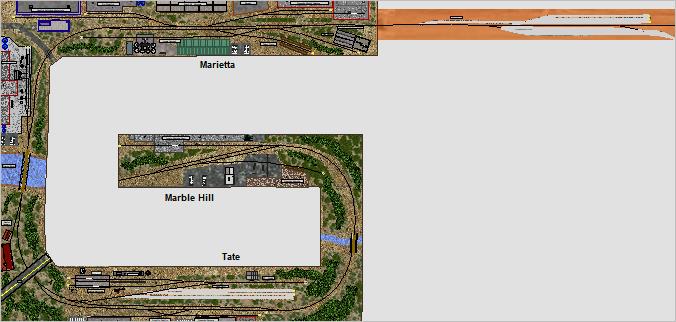 |
| Gobblers Knob | 13 x 25 | Gobblers Knob is a fictitious subdivision of the 2ft Gauge SR&RL Railroad extending north from Bigelow to service the sawmill complex at Gobblers Knob and to connect the railroad to the slate quarrying industries in the northern mountainous region of Maine. Outgoing traffic is comprised mainly of pulpwood and slate, and the Ahern Slate Quarry requires copious amounts of sea sand to be brought in for slate polishing. You will operate either the Daily Mixed train from Bigelow North to Naylor via Gobblers Knob, or alternatively the Pulpwood and Logging train which usually operates during the night. The Daily Mixed train must stop at all passenger stations in accordance with the sequence shown on the top of the combine. All townships will be visited in numerical order and you should block your train accordingly before heading out. You are also free to run any extra trains that you deem necessary to complete your switchlist. Your engine has been prepared by the hostler at the Bigelow North engine shed and you should start by heading south into the Bigelow yard to assemble your northbound train. |
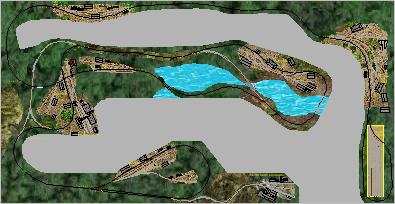 |
| Grant Harbour Belt Line | 27 x 28 | The Grant Harbor Belt Line is a modified version of a similar design by M.C.Fujiwara, owner of Yardgoat Layout Designs. This fictional room sized layout features a Short Line operator - the Grant Harbor Belt RR which services the customers in the immediate harbor area. Their main connection with the larger market is via the Northern Pacifc RR. The largest customers on the Belt are Sadler Brewers and the Harbor Pier. As well there is the typical variety of mixed light industries ranging from manufacturers, chemcial companies, warehouses and a feed mill. Your switch engines are found on the Ready track in the Belt Line Yard on the bottom west side of the plan. |
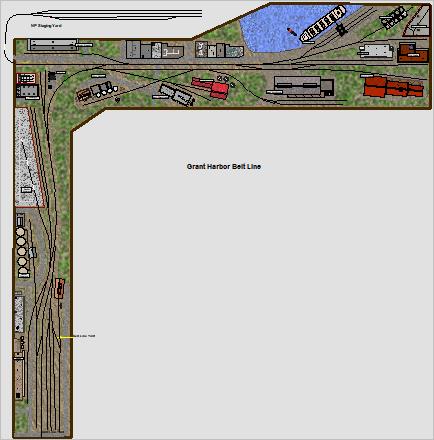 |
| Gray Eagle Branch | 8 x 43 | This room sized layout is a fictional representation of a typical Class 1 RR branch in southern California in the mid-1950s era. This town boasts a couple of packing plants, a busy cement production mill, a soda bottling plant, a candy maker, a furniture business, some warehouses, freight depot and a team track for smaller LCL customers to use. There is a well worn S1 diesel which keeps the rails shiny by working 6 days a week moving freight in and out of town. Some of the traffic flows to the Union Pacific Interchange which is close at hand. |
 |
| Greenwood | 11 x 16 | Greenwood is an important sub on the Erie RR which has a interchange with the nearby PRR and several important local customers. Brison Cattle sends 4 loads daily to market via the PRR. Meadow Dairy ships milk and dairy products to market daily via the Erie and receives a couple of cars daily as well. Garner Lumber serves a growing local market and can receive 3 or 4 loads daily in season. Ideal Hardware primarily receives and stores products bound for local businesses by truck. The largest customers in town are Madison Mill which receives 4 - 6 loads of raw materials daily and ships 4 - 5 loads of finished goods daily as well; and Lawson Foundry which receives coal and ships steel plates and rails. |
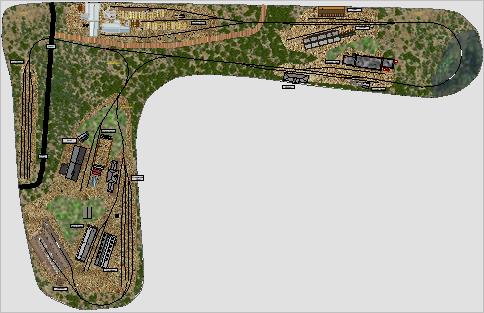 |
| Hampstead | 9 x 9 | Hampstead is a point to point room sized layout with a small yard and a separate staging yard. There are 3 large industries in the community - Arco Machinery, Fortin Papers and Napa Parts, as well as several other small to medium sized businesses. There is also a short out-and-back passenger run using a Doodlebug. |
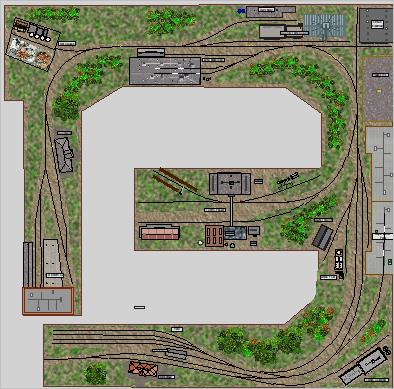 |
| Hawkins Junction | 18 x 36 | Hawkins Junction is an around-the-walls layout depicting a key junction point, near the end of large division, which leads to two branches with several decent sized industries to service on a daily / weekly basis. The location is the American industrial mid-west, during the early 1960s. Manufacturing is still booming as are resource based industries. |
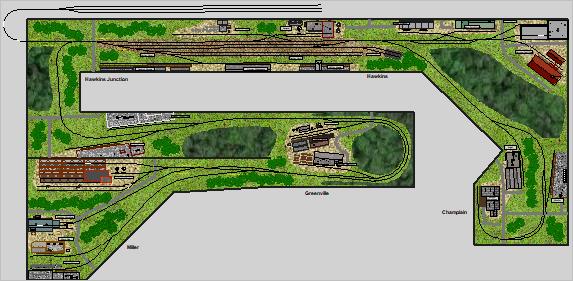 |
| Home on the Grange | 25 x 29 | "Home on the Grange" is a room sized layout set in the 1960s - 1970s era, in middle America - the "bread basket" of the nation. Most of the industries are focused on agricultural products - production or distribution. There are 2 large grain elevators, smaller feed and seed mills and some canola and soybeans being shipped to markets. As well, there are a few supply businesses which provide either hardware or equipment, or seeds and fertilizers. Peak season is obviously during harvest times from late August to early October each year. Outside of those months, the overall traffic is relatively light. In the south, there is an interchange with the Norfolk Southern which forwards loads to the east and gulf coasts. Generally, all non-NS traffic flows out from the Staging Yard in the north and returns to it. |
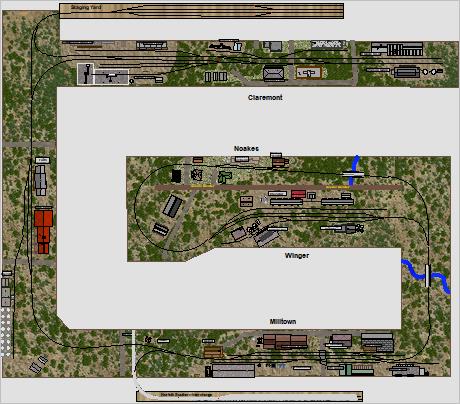 |
| Huron Terminal | 18 x 23 | Inspired by a room sized plan of the same name from the October 2010 Model Railroader magazine, this layout focuses on a short line railroad which handles the transport needs of the small mid-west city of Huron in the early diesel transition period. In addition to several small to mid-sized industries, the Huron Terminal RR has an interchange with the GTW which is its link to outside markets and its main source of incoming "foreign" traffic. |
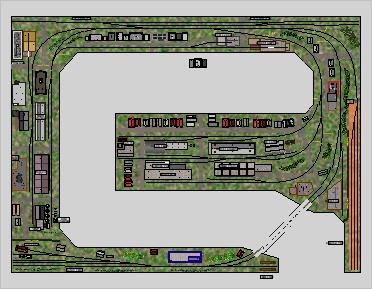 |
| Industrial Spur Sparks NV | 25 x 70 | Sparks Nevada is a city of 90,000 people in 2016. It is on the eastern boundary with the better known Reno NV. The Union Pacific Railroad runs east/west through the center of Sparks and close by their major yard there, that's where you will find this industrial spur. All of the industries named on this plan are real, rail served customers in this area and they are a mixture of light industry and warehousing services. There are runaround tracks for easier and quick access to these sites. An SD40-2 from the Sparks yard handles the daily peddler turn for this zone. |
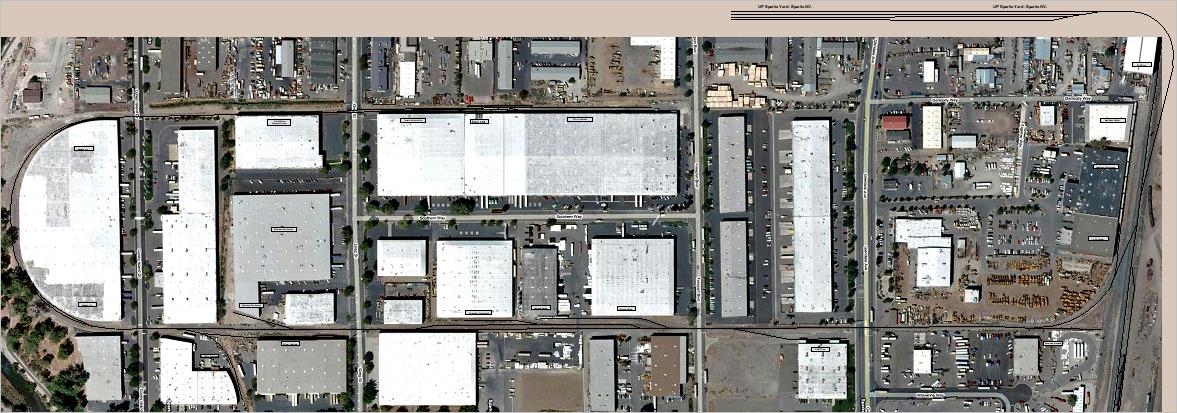 |
Ironwood Branch |
20 x 30 | The room sized,fictional Ironwood Branch is connected to its parent class 1 railroad, the CNW via the hidden staging areas. The Ironwood Branch, which is set in the late 1940s era, includes some produce packers, light manufacturing, farm service and supply businesses, plus a busy ore mine, a medium sized gravel operation, a cement supplier and a grain elevator. In addition, there is still a passenger service which runs on alternate days from St. Paul to Chicago. |
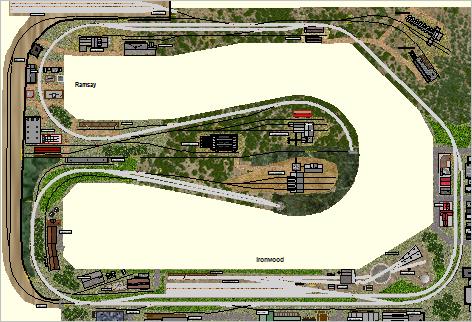 |
| Klose Korners | 6 x 9 | Klose Korners is a whimsical corner layout plan, depicting the far end of a subdivision. A lonely SW1 switcher handles the meagre switching duties in this late 1950s era town. There are 7 light industries to service via a small yard near the centre of town. |
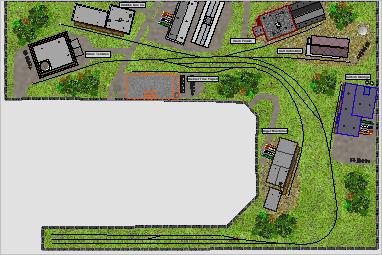 |
| Lakeside | 20 x 23 | Lakeside is a medium sized port in the US southeast. It is focused on the local fisheries and fruit and produce growers. There is a mid-sized ADM grain mill to service along with a fairly busy Interchange with the FEC. You have control of a couple of switch engines to handle the freight traffic. There are some generous runarounds to ease your burden. |
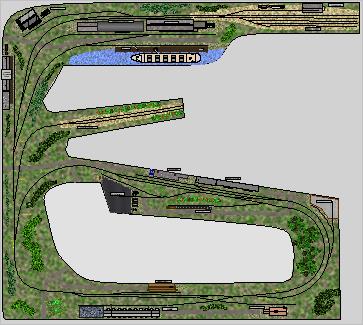 |
| LIRR_Montauk sub 1960 | 27 x 39 | Nick Kailis Long Island Railroad [LIRR] Montauk Branch - this densely industrialized, urban railroad is based in Long Island City which was once an independent city until Queens County was absorbed by New York City circa 1898. During the era modeled, the 1960s, the LIRR owned no revenue freight cars as online industries shipped out comparatively little. While all LIRR freights ran as extra movements not listed in the timetable, freights did operate on a schedule. Throughout most of the 1960s, most LIRR yard jobs worked seven-days-a-week. All LIRR freights are in reality locals. Most traffic on this layout is generated offline. The Long Island makes interchange with other roads at Long Island City (NYC, DL&W, PRR, E-L, LV, B&O, New York Dock). Here is Nick Kailis' web site information: http://www.trainsarefun.com/lirrmb/layoutdescription.htm |
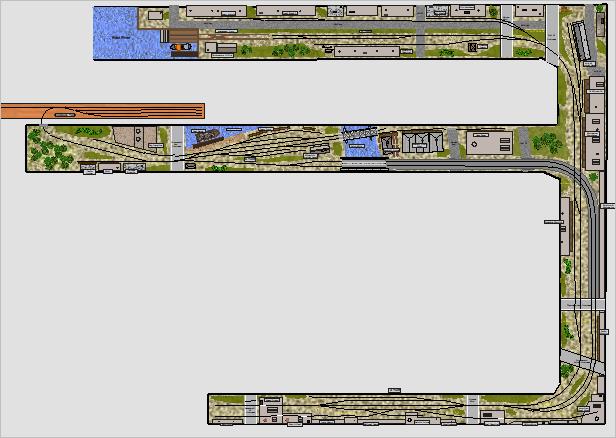 |
| Loganville | 15 x 16 | This room sized layout focuses on the industrial town of Loganville which is dominated by the large and active Patriot Paper mill. The Delta shortline which services this area has a modest yard with an interchange with the Norfolk Southern. Delta RR also has a few other medium sized customers - like Forte Cement and PenTex Fabrics. The time period is early modern era. |
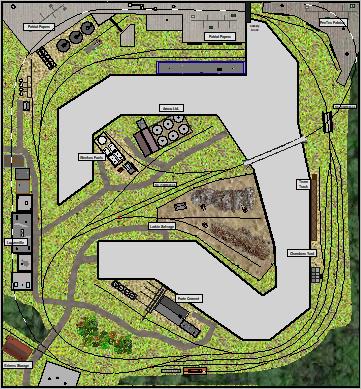 |
Long Branch |
6 x 103 | At the end of an upstate New York subdivision, you will find this fictional Long Branch. The time period is the early 1950s and diesels are running the show on this branch. Overnight, the big steamers from the subdivision yard drop off a daily string of cars for the Branch at its Staging Yard. The pair of SW1s will pull the cars, which are bound for each town on the branch, from Staging to the respective outbound track destined for each of the towns. Passenger service has already disappeared but the Branch is kept busy serving a mixture of light and medium industries which range from lumber suppliers, a plywood plant, two manufacturers, a small cement plant, food producers and distributors, a fertilizer plant and a couple of chemical firms and other businesses. |
 |
| Maple Grove | 30 x 57 | If you enjoy the challenge of switching railcars in a busy urban setting, then you're ready to tackle Maple Grove. Set in the mid-1930s when cities grew to encompass previously wide-open industrial parks, Maple Grove features many small to medium industries serviced via short, sharp curved tracks by either a 25 ton diesel or a smaller 0-6-0 switch engine. There are a few runaround tracks, but you will need to plan your moves carefully to take advantage of them. |
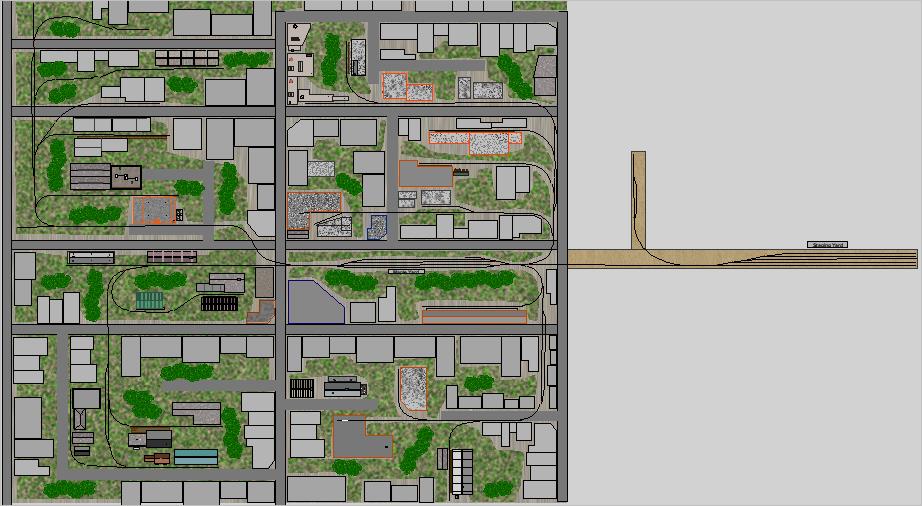 |
| Marsden Sub | 21 x 22 | Paul Larson designed the original layout called "Iron Ridge & Mayville" as a point-to-point railroad and it appeared in "101 Track Plans for Model Railroaders" by Linn H. Westcott as plan L# 68. We have re-interpreted that original design but kept it as a point-to-point layout which now functions as a secondary branch of the MILW, serving a timber / mining based economy in the central US during the 1930s era. There is a good range of industries along the route which generate a modest amount of revenue traffic on a weekly basis. At the same time, there is still a small passenger service to the 3 towns along the Sub. |
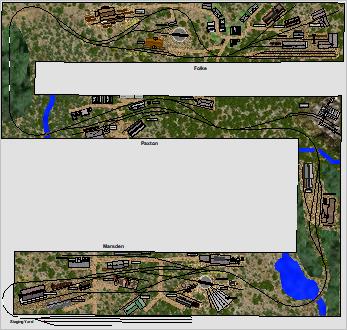 |
| Marsville | 16 x 19 | Marsville represents a small industrial area near Vernon CA in the modern era. To the south is the main Marsville Yard where traffic will enter and exit from this zone. There is also the small Palliser Yard to the north end for car cleanout and inspection before re-assignment. The light and medium industries are typical of the ones found in this vicinity in the 1980s. |
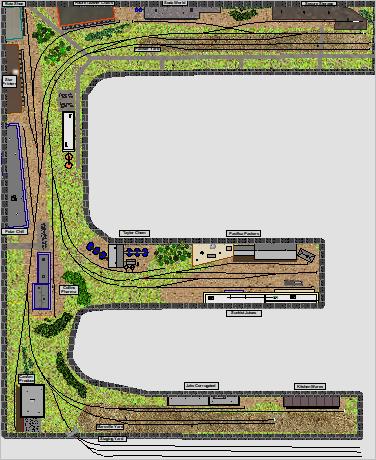 |
| 12 x 8 | McClellan is based on a track plan supplied by John McClellan in June 2020. This is basically a twice around with a switch yard at the bottom, a small station at the top then above the station is a switchback going up the side of a mountain to service a small community at the top. We have added a few extra industry spurs to provide an engaging operating pattern. Apologies to John for removing one crossover track which short circuited our ops plan (only he knows where it was if he wants to put it back). |
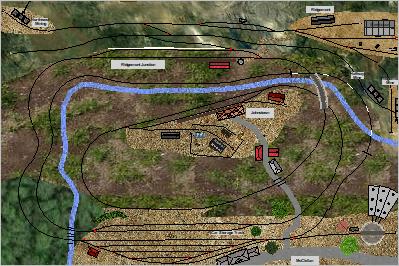 |
|
| Midthorpe Branch | 13 x 18 | Midthorpe is based on a Trainplayer layout originally designed by B Pigozzo in July 2013, modified for YardMaster in August 2016 and updated for Advanced Ops in June 2018. This room sized layout plan depicts a fictional British city whose industries are still being served by rail. It also has passenger service between towns. |
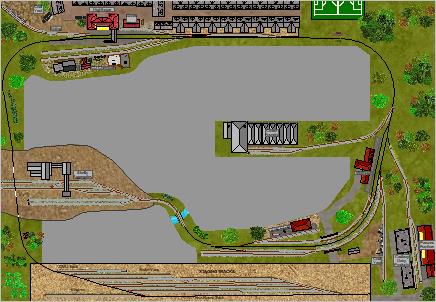 |
| Mill Creek District | 31 x 49 | The Mill Creek District is a late 1960s era industrial/resources based zone in the foothills region of the BN's north west Pacific region. The first section of the district is dominated by a large cement plant, a gravel pit, and a coal mining operation and 2 forestry related industries. The lower section of the district has a mix of light manufacturing businesses, warehouses, a dairy, a transload company, a lumber yard and a coal pier. There is a daily train which handles the upper area from the Staging Yard. In the lower portion of the district, there are engines from Truscott Yard which handle the local traffic. Trains operate 5 days per week. |
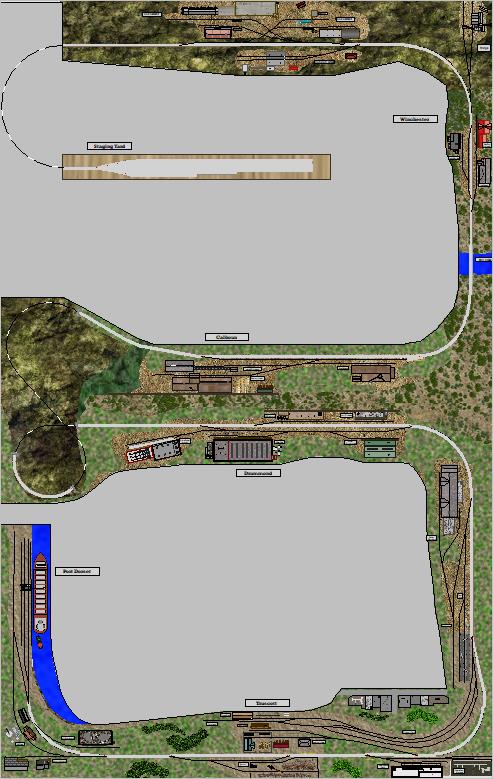 |
| Mimico St. Spur 1932 | 29 x 31 | This fictional Mimico St. spur in 1932 was a typical branch off the CNJ Hoboken district in the 1930s. It runs off of the nearby mainline yard to service an industrial zone with several large customers ranging from light manufacturing, to warehouse, distribution and food services. "On street" running was fairly typical at that time when the motor car had not yet taken over the roadways. Your 4-6-4T Hudson engine has its work cut out for it. There is but one runaround track within the small yard. So servicing customers on Mimico St. will take some careful set up of your train in the yard to ensure your work is done efficiently. |
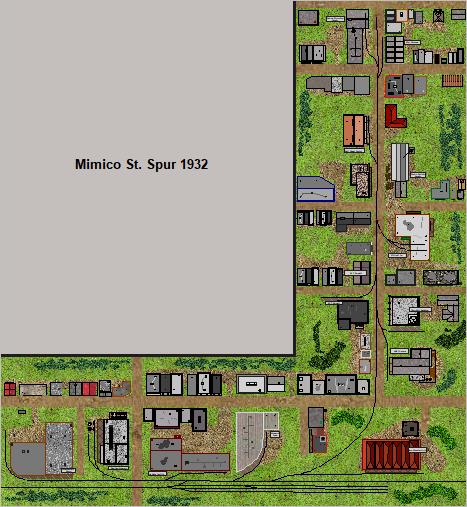 |
Minnesota Transfer Railway |
11 x 20 | Another of Stein Rypern's favourite railways was the Minnesota Transfer Railway (reporting mark MTRY),a switching and terminal railroad in the Twin Cities of Minneapolis & Saint Paul in Minnesota. It was owned jointly by no less than nine class 1 railroads! A lot of the traffic of the MTRY was interchange between the owner railroads. But in Stein's basement empire of the MTRT, he focused on local switching for quite a few industries located along its line. There was also a large Freight House which operated a common LCL (less than carload) service for several of its owner railroads. His layout was based on the MTRY ca. 1962 with all diesels and mostly 40 foot cars. The key industries here are the Freight Warehouse, Williams Manufacturing, Archer Daniels and the barge terminal. |
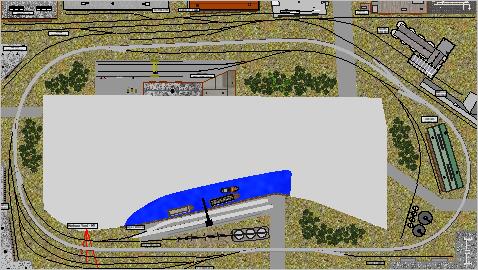 |
| Muncaster Terminal Railroad | 5 x 19 | Muncaster Terminal is an "around the walls" shelf layout,designed with point-to-point operations in mind. There is a staging yard at Muncaster and in between there is a distribution centre,a cold storage facility, a Team Track with crane and ramp for unloading, a textile mill, a scrap yard, a Soda pop bottling company, a lumber supply and a bakery. There will be enough rail traffic to keep you busy and interested. |
 |
| New Lisbon Branch | 19 x 46 | New Lisbon was part of MR's Gordon Odegard's modular home N scale layout of the same name. His layout was a way to test the scenic and modelling capabilities of what was a new scale in model railroading. Fortunately, Gord was a skilled scratch builder and contributed many articles on working/modelling in N scale in the mid-1970s and 1980s. The New Lisbon was a small branch off the MILW main line through Wisconsin back in the 1950s. We have expanded on the original module [featured in the MR Oct. 1976] by adding a run to an ore mine, providing a Mixed passenger service and working with a functional interchange with the CNW. |
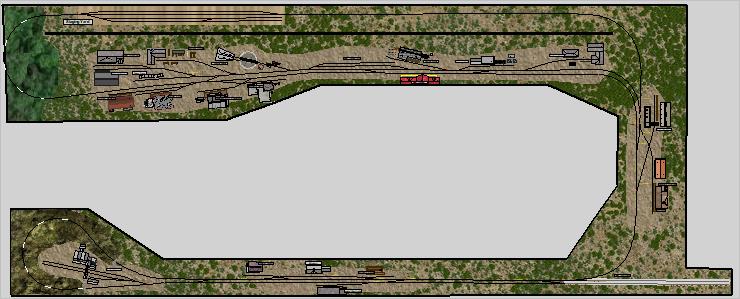 |
| Norwich Sub | 15 x 39 | The Norwich Subdivision consists of the 3 medium sized cities - Norwich, Highgate and Kearns. The main customers along the Sub are Monarch Flour, Allied Chemicals, Vera Plywoods and Kingsmill Steel Works which together generate hundreds of car loads per year. There is also a good blend of other medium and light industries to help keep the rails shiny. There are 4 SW9 switchers assigned to the sub to keep the traffic moving efficiently and smoothly |
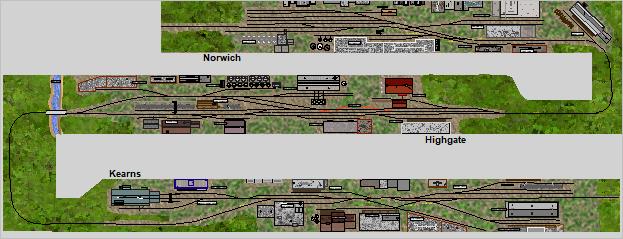 |
Oildale Branch - Rev |
15 x 15 | Oildale Branch - Created by Bruce MacLeod 2019 The Oildale Branch is my modified version of a real branchline located near Bakersfield, CA which served an active oil field. In my version, there are two oil loading facilities and three industries around the Oildale Yard area, and two industries in the outskirt area. The hidden helix allows the trains to drop down to the Mainline Yard which is hidden under the Amoco facility but which I have shown at the bottom for easier operations. The operations on this branch are really simple. The oil facilities simply ship loaded tank cars of crude oil to the mainline yard for distant refineries. Empty tank cars are sent from the mainline yard to the Oildale yard for dispersal to the loading facilities. The remaining industries receive and/or ship loaded cars and/or empties between Oildale yard and the mainline yard as needed. This layout is based on the 1940s, so steam is still king. The engine service area exists to provide and/or service two 2-8-0 Consolidations for movement between Oildale yard and Mainline yard. |
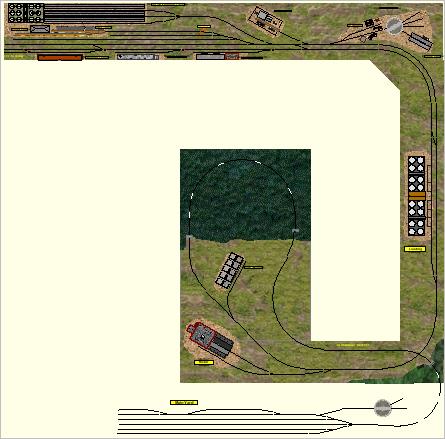 |
| Orchard Park Zone | 15 x 16 | Orchard Park is a small industrial zone on the Penn Central RR,near Buffalo NY set in the late 1930s. There is a mixture of light manufacturing plants in this zone which are serviced via Orchard Park Yard and the nearby New York Central interchange. |
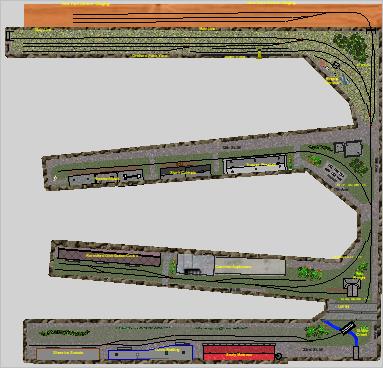 |
| Otter Point | 7 x 29 | Otter Point is a room sized layout which depicts a busy branch that services the crowded industries around a busy sea port. Not surprisingly, the industries are based on import/export of basic bulk commodities like fish, produce and grains. There are a couple of speciality marine businesses and a medium sized chemical plant modelled as well. The time period is the early 1960s era. This plan is generally based on the L10 - Port Ogden & Northern layout from the Westcott 101 Layout Plans. |
 |
| Packers Bay | 5 x 25 | This room sized plan, based on the modern era, incorporates some typical traffic patterns for a mid-sized port city in the central USA called Packers Bay. There is an eastbound fast freight which services both the grain mill and the cement plant on its way to Chicago. It also includes some bridge traffic flowing from Minneapolis to Chicago. The westbound fast freight speeds through town to return empty hoppers to the Minneapolis area. Packers Bay receives a block of cars bound for local customers, all of which will send and receive several car loads daily. There is a modest classification yard called "B Yard" in the west of the city where trains / cars are sorted and temporarily stored while they are in transit. |
 |
| Palace Rd. Wharf | 11 x 18 | This layout is inspired by Andy Sperandeo's First and Alice Street Yard in Model Railroad Planning 2014. The setting is the mid 1950s when the Alice Street Yard was a self-contained industrial yard of the Santa Fe, serviced only by ferry barge, that served a handful of clients in Oakland, California. |
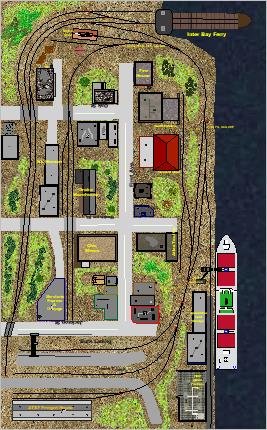 |
| Penwirth Branch | 16 x 31 | The Penwirth Branch is an around-the-walls with a peninsula layout plan depicting a fictional GWR branch line during the early 1920s. There is a coal mine and some other industries in the countryside which are still rail served and some smaller merchants in the two principal towns - Allynford and Penwirth. There is also a daily passenger service which stops at both towns before returning to the Staging area. |
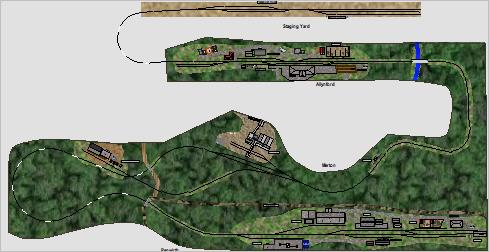 |
| Peterboro sub | 19 x 44 | This shelf layout is based on Trevor Marshall's Free-Mo modules of the same name. In our version, we have added a Staging yard which will be the source and destination for all traffic on this layout. There is a good range of local industries represented on the plan and some interesting switching challenges to test your skills. |
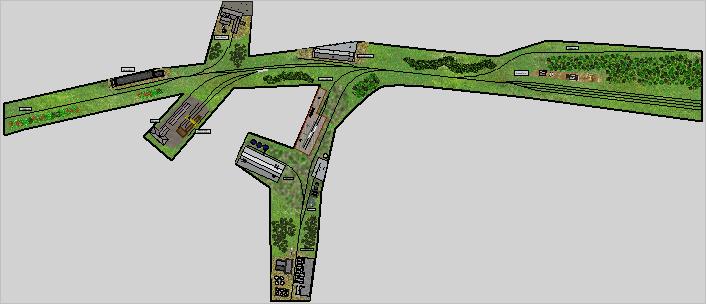 |
PGR Air Lake MN |
12 x 19 | Stein Rypern was a N gauge enthusiast from Sweden who modeled several shortlines in Minnesota, set in the 1970's and 1980s. Since he only had limited space for his home layout, he focused on the Progressive Railway's Air Lake Industrial Park which, in this time period, had 20+ rail-served customers in one small size land space. There were no runaround tracks as such. So the PGR used 2 GP15s to handle the switching, with one at the head end for trailing point moves and the other at the tail end for facing point moves. The crews tended to do the spots and pulls at the same time, so they had to plan their various moves well in advance to avoid getting "locked in". |
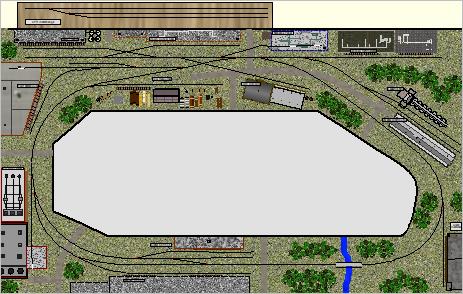 |
| Pickens Turn | 23 x 30 | Pickens is a fictional subdivision of metro Chicago set in the late 1980s. There is a decent mix of rail traffic generated by a couple of grocery warehouses and some mid-sized manufacturers. To the west end of the layout there is also an interchange with Chicago Belt Line RR which processes a number of cars headed for the local industries. |
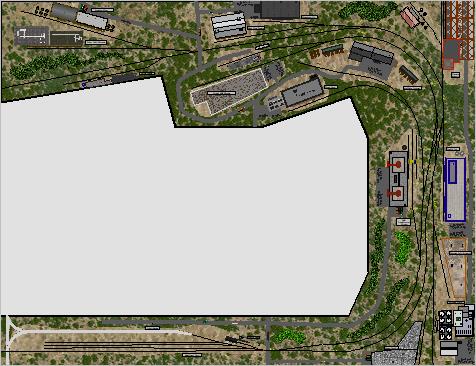 |
| Port Andrews | 16 x 22 | Port Andrews is an ocean port in northern Washington state. It is primarily serviced by a fictional shortline railway - the Washington Northern [WNR], a subsidiary of the Great Northern. The time frame is the early 1990s. There are two important sources of daily rail traffic - the Raven Pulp & Paper mill and the few fish plants/food distributors. As well there are some light/medium industries including a ready mix cement plant, a salvage dealer, a roof truss manufacturer and a manufacturer of copper tubing, pipes and connectors. Smaller customers and LCL clients are served via a team track. This plan is inspired by Kevin Klettke's Washington Northern layout. Visit his web site here - http://www.wnrr.net/overview.html. Permission Pending. April 2014 |
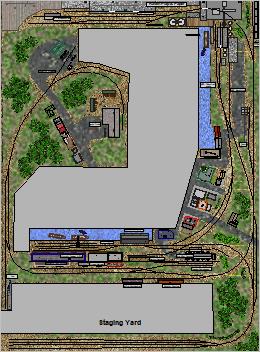 |
| Port Byron | 11 x 18 | This layout grew out of a Byron Henderson design - 6th Street Job, San Jose CA which is included in our Featured Layouts\Byron Henderson Designs folder. One of the largest customers on this railroad is National Gypsum which in the real world, would receive / ship about 50+ loads a day. For this model, that number is scaled down to about 14 daily loads.The local industries all generate a few loads per day as well. The other large customers are the Team track and LCL load area and the Atlantic Trading Co. which receives a wide variety of loads bound for overseas shipment. Port Byron's 10th Ave. Yard is located on the east side of the plan, while the Willow Industry Yard is located south of the wharf. |
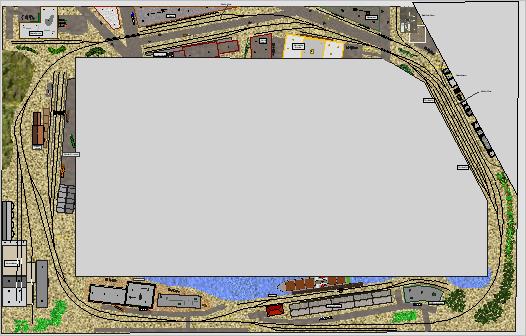 |
Portland Terminal RR |
41 x 43 | The Portland Terminal Rairoad [PTR] principaly serves the Guild Lake Industrial Sanctuary which is close to the downtown business area. The PTR interchanges with both the BNSF and UP railroads which traverse the area and connect many of the area's industrial businesses to the national railroad network. This plan is based on a Google Earth satellite view and actual customer names and sites Portland Terminal Railroad's Lake Yard, which features multimodal shipping connections and warehousing facilities, also links to several major local businesses including Owens Corning - Portland Roofing Division, Boise Cascade, Portland Bolt & Manufacturing, an Amazon Flex warehouse, and Crescent Electric Supply along with some other customers. |
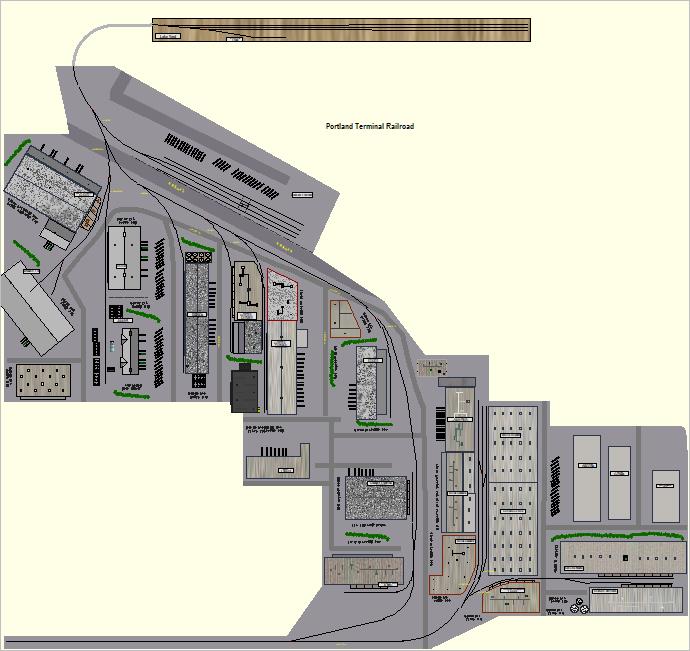 |
| Potter Industrial Park Branch | 12 x 13 | The Potter Industrial Park Branch is a fictional room sized layout. This branch which is set in the early 1950s era,runs off the BN mainline in Washington state and services a number of light manufacturers and food processing facilities. The branch is busy enough that the small SW1 switcher services the various industries up to 3 times per day. |
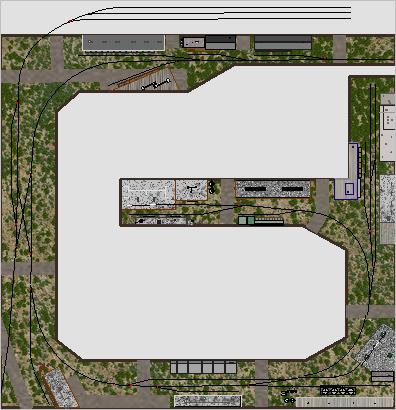 |
| Pureland Industrial Complex | 16 x 27 | Pureland Industrial Complex, which opened in 1975, is a 3,000-acre industrial park located in Logan Township in Gloucester County, New Jersey near I-94. SMS Rail Lines,which is a regional shortline carrier based in Pureland, services the complex and interchanges with Conrail Shared Assets Operations which also connects to Penns Grove Secondary and the national rail network. There are several large customers who have major warehousing and production facilites located in this busy complex. |
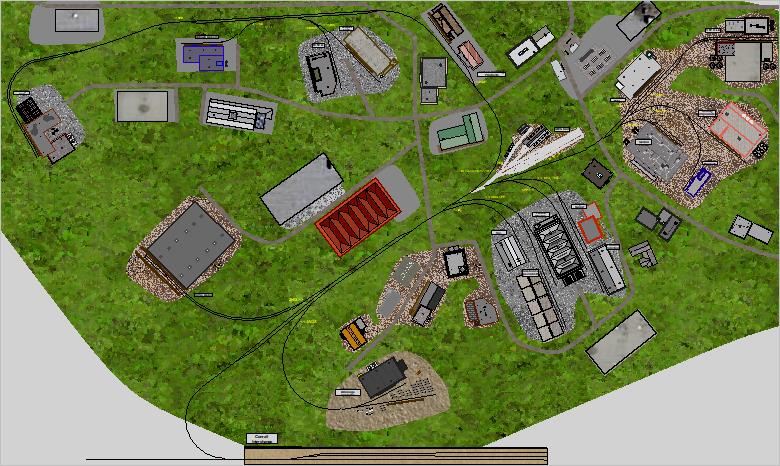 |
| Red Hawk District | 21 x 106 | This plan - Red Hawk Sub, is based on the MR modular shelf layout plan for the Chicago Belt Line RR. The Red Hawk is a short line which connects with both the BN and the UP via the Baird Staging Yard outside of Chicago. It is set in the modern era and is made up of 3 industrial zones Cicero, Darien and Elmhurst.Most of the engines are based at the Baird Staging Yard but there is also a lonely GP38 parked at Darien Yard to service the far end of the district. This area features a mix of light industrial activity with the emphasis primarily on manufacturing and warehousing. The small transload facility, the General Mills elevators and the Illinois Power Corporation plant, all receive enough traffic to warrant special daily runs to service their needs. There are several strategically placed "run-around" tracks to ease your switching chores. Use them wisely |
 |
| Red River Sub | 24 x 24 | The Red River Sub is located on a fictional Class 1 railroad in the US midwest in the late 1960s. There are 3 major centres here - Jackson, Bradshaw and Manning. Each town has its own blend of agricultural businesses and light manufacturers. The freight / bridge traffic moves both north and southbound during the day via a couple of fast freight trains, each of which stops briefly at Bradshaw Yard to pick up and drop off some cars. There is a large Georgia Pacific paper mill in the north end of the Sub and a medium sized UPI ethanol plant in the south sector. Both of these are serviced by turn jobs from S4 engines based in each yard. The S4 based in North Yard services Bradshaw and the other S4 travels from the South Yard to work Manning and the UPI Plant There is still some light passenger service via a morning and evening RDC run, called the MetroLiner. |
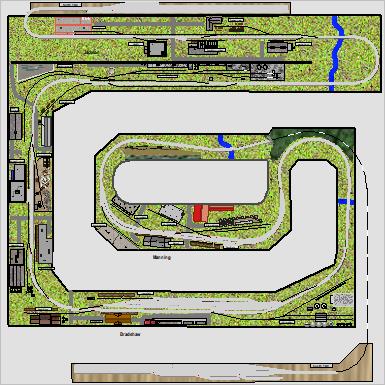 |
| Ronson Branch | 22 x 25 | The Ronson Branch is a fictional railroad which runs off of a major Class 1 railway in a typical urban industrial zone. This zone consists of medium and light industries including natural resouces, light manufacturing and auto parts factories. The time period is the mid 1980s. The Branch has a suitable yard at its southern edge near to where it joins the Class 1 mainline. The branch also has a smaller yard to service the needs of the industries to the north end of the line. There are 2 recycled engines - a GP35 and GP38, assigned as motive power for the Branch. |
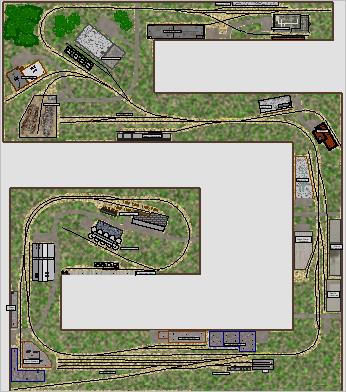 |
| Royalton Branch | 8 x 17 | Set in the early 1930s, the Royalton Branch was a busy small town in the eastern US with an active coal mine and a few small local industries. Since it was located in the foothills close to the coal mine, the B&O provided both freight and passenger services to the town until the late 1940s when the branch was closed. |
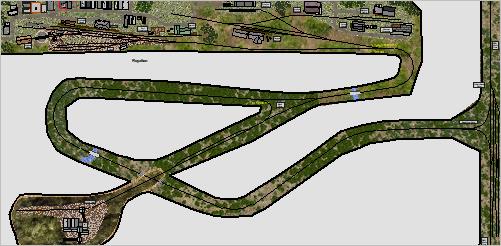 |
| Salton Junction | 32 x 44 | The Salton Branch is a fictional branch line of Penn Central class 1 railroad in the early 1980s. Salton is located in the western part of New York state in an area where there are still some major resource industries - coal mine, gravel pit and a lime plant in the rural parts of the branch. In the urban areas, there are several medium industries [brewery, cardboard box plant, furniture and appliance manufacturers and a mid-sized transload facility] which require daily service. |
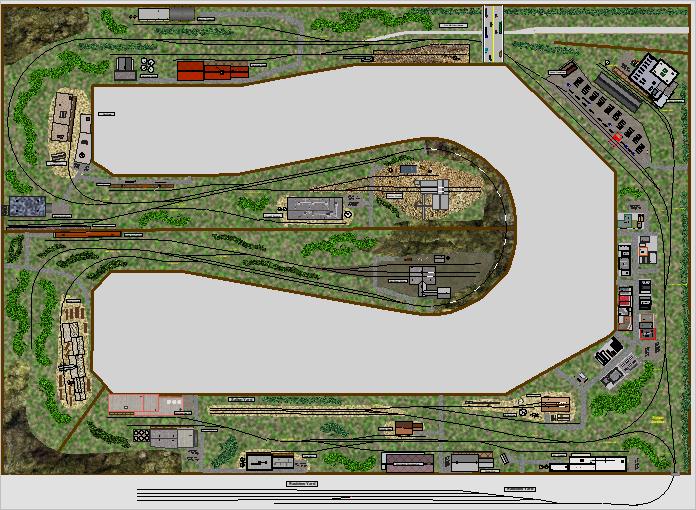 |
| San Jacinto District | 6 x 9 | San Jacinto District is a 6ft x 9ft switching layout designed by Andy Sperandeo of Model Railroader to fit into a spare bedroom. The San Jacinto District is located in the Garden belt of California and so features 3 packing plants, an ice house and a cattle export site. Trains are generally very short - no more than 10 cars with engine and tender. |
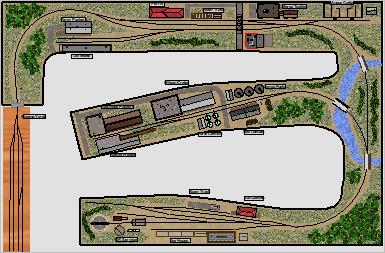 |
San Pedro Rail |
36 x 36 | The San Pedro Railway is a fictional, wholly owned short line subsidiary of the Union Pacific Railroad. It owns and operates this busy district near San Diego CA. There are a few larger businesses like Linamar Automotive, BASF Chemicals, Gage Elementals and Pallet King, all of whom generate many car loads per week. As well, there are about 20 other small and mid-sized industries in food services, warehousing, light manufacturing and distribution services to keep the two San Pedro SW 1500 switchers hopping. The time period is set in the late 1960s. |
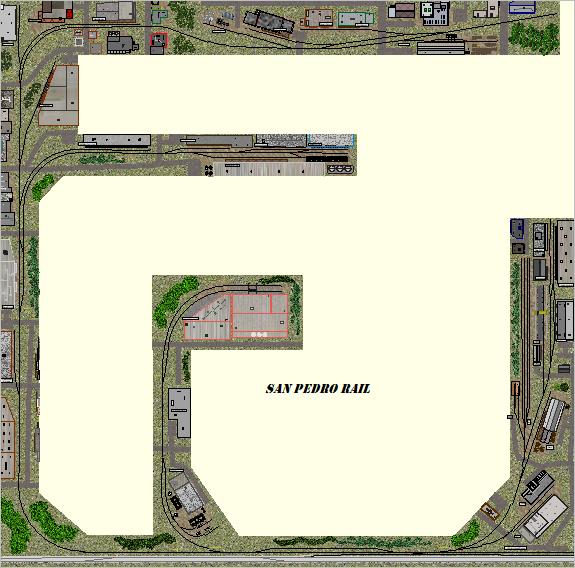 |
| Sebring Branch | 17 x 21 | This eastern US short line layout depicts an entire branch line by folding track back on itself in an "out and back" mode. The main Sebring Yard is located on the bottom left side of the plan. Trains leaving the yard quickly disappear into a tunnel and emerge out on the branch to do their work. |
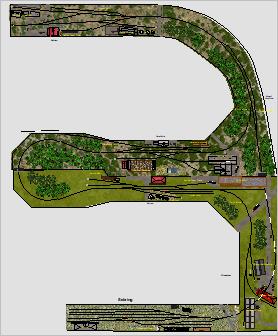 |
Slocan City 1947 |
21 x 39 | Founded in 1892, Slocan City was the smallest incorporated city in the British Commonwealth, perhaps in the world with a population with 6,000 people. The booming lead /silver mining town served as the terminus for the railway coming in from Nelson BC, and sternwheelers plied the lake carrying minerals, goods and people. Silverton was a thriving silver/lead mining town near Idaho Mountain just south of Slocan City in the early 1900s. By the 1920s, mining was in decline but Triangle Pacific, a major pulp and paper mill, arrived and kept the local crews quite busy with loads of logs, wood pulp and wood chips. Today, Slocan, whose population is less than 600 people relies primarily on tourism |
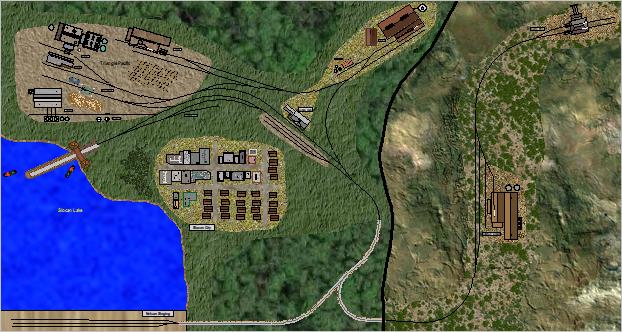 |
| Stillwater Sub | 20 x 40 | This point to point layout is a fictional depiction of a branch of the CBQ going west to Minnesota in the steam-to-diesel transition era of the 1950s. The line starts at the Stillwater Yard and winds its way through the countryside and services several medium light and heavy industries along the way, before reaching Parkdale. There is an interchange with the CNW where cars are exchanged 3 days per week. |
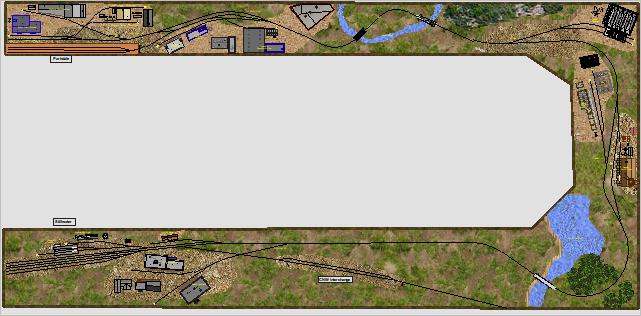 |
| Store Street Victoria BC | 20 x 41 | This shelf layout represents a portion on Store Street's industrial zone in Victoria British Columbia in the early diesel period. This busy industrial area is served by a long CP spur with no run-around track. You MUST use the yard to set up your train in the correct switching order and your shunting moves need to be carefully worked out in advance. |
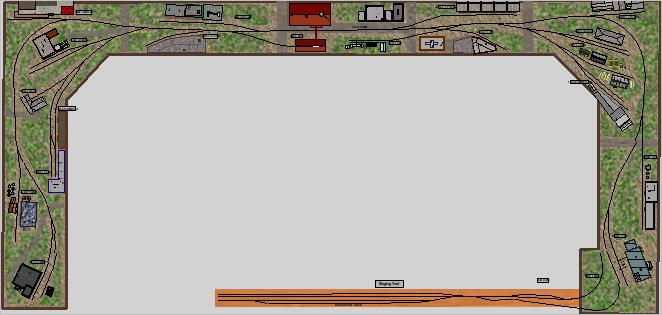 |
| Strickland Industrial Basin | 12 x 68 | The Strickland Industrial Basin is a typical commercial/industrial development near a medium size city. This shelf layout contains a paper box manufacturer and a brewery which rely heavily upon rail service to meet their service requirements. This layout is set in the modern era with its larger/longer rail cars. |
 |
Sugarland Sub |
15 x 16 | This room sized layout is inspired by "Big Island Rail" from the 103 Realistic Track Plans from Model Railroader. It is obviously focused on sugar production - moving sugarbeets from the distant farm fields to the factories where it is processed into raw and refined sugars and into liquids like sucrose and fructose. This plan allows for a "continuous running" option via the main line. There are also some runaround tracks to ease your switching duties. The time period is the early 1970s in the western Minnesota. You have a GP38 road engine and an SW1200 at your disposal. |
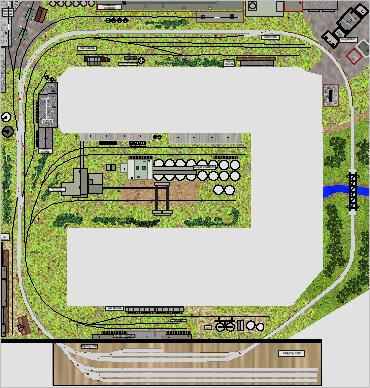 |
| Sumner Division | 27 x 65 | Sumner Division is a fictional part of the Kansas Dakota Railway [KDR]. Its largest customers are the United Co-op and Victory Coal which generate many car loads daily. As well, there are over 20 other light and medium industries which require rail services. |
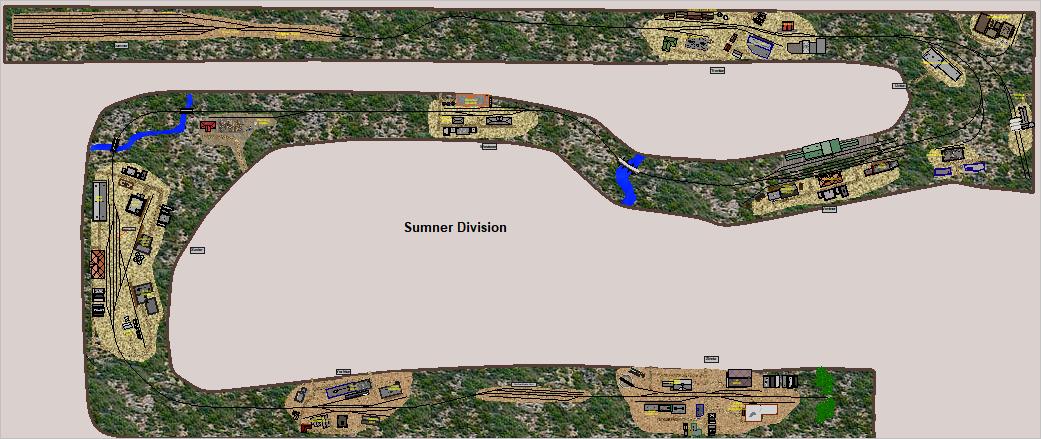 |
| THB Dundas Branch | 18 x 23 | THB Dundas Branch is a fictional representation of the Toronto Hamilton Buffalo RR track work through the countryside around Hamilton. Several of their main customers are depicted on this late 1940s era layout. |
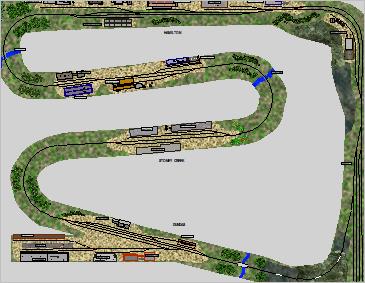 |
| The Mariposa Line | 30 x 39 | The Mariposa Line is an independently run short line operation which has an interchange with the Penn Central RR included in its main yard at the south end of this plan. The time period is the early 1960s, and traffic has been declining for a while. The Dominion Pulp and Paper and the Rueter Mill are the lifeblood for the Mariposa. There are a few other smaller industries located on line. The Mariposa has 2 Alco S2 engines to work the 3 short, daily trains on its schedule. |
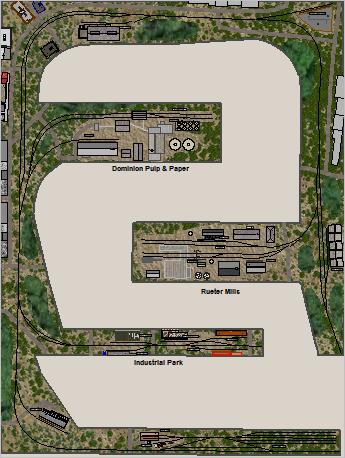 |
| The Potteries | 5 x 9 | This track plan is loosely based on industries in and around Stoke-on-Trent in the mid- 1930s. Stoke-on-Trent has been almost exclusively known for its industrial-scale pottery manufacturing as exmplified by Royal Doulton, Dudson Ltd, Spode, Wedgwood, Minton,and Baker & Co. which were established and based here. The local abundance of coal and clay suitable for earthenware production led to the early development of the local pottery industry Shelton Steel Works produced steel goods like plate steel and steel rods. The Michelin tyre company also had a presence in Stoke-on-Trent, and in the 1920s built their first UK plant in the city. |
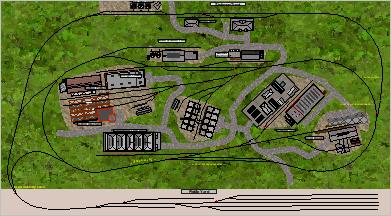 |
| The Virginian | 12 x 16 | This is Chris Pedersen's rendition of the MR "Virginian" project railroad which first was introduced in Jan. 2012. The Virginian was a big time US Class 1 coal hauler line moving coal from mines in the West Virginian lowlands to shippers on Chesapeake Bay. Coal movements accounted for 85% of the total traffic moved over this line's history. The Virginian featured some of the largest steam, electric and diesel locomotives of the day. They were quite profitable right up to their merger with the Norfolk Western in 1959. MR's David Popp did the original 4x8 track plan for this layout. Then the Turtle Creek module was added to the west and later still the "thin branch" to the south and east. Chris Pedersen has provided a richly detailed layout which captures the spirit of the Virginain RR and which takes advantage of the high zoom capabilities of TrainPlayer. |
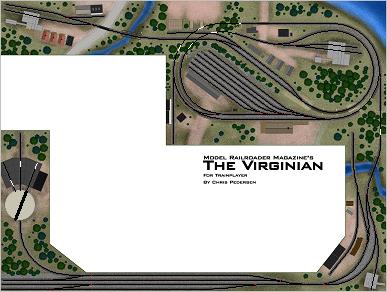 |
| Tic Toc Dock_Ry | 16 x 22 | Tic Toc Dock & Railway is a small railway which serves a small, remote seaport. It receives most of its cars from either the daily car ferry based in Toc or, via its main line connection not far from Tic. The TTDR services several local customers with its 2 small diesel engines. One or both diesels may be involved in servicing the car ferry, and this is true for working the small Tic yard. |
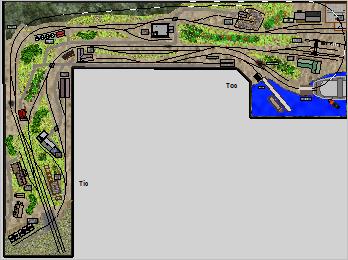 |
| Toledo & Western RR | 20 x 28 | The Toledo & Western was a small short line located largely in Ohio. Its main centre at Sylvania, a suburb of Toledo, had a modest yard from which it serviced the communities of Adrian and Blissfield. Close by Adrian was an interchange link to the larger Wabash Railroad, which in turn provided connections to broad American markets for all of this region's industries. The best years for the T&W were the 1920s until the mid 1940s. Not long after WW2, this line was bought out but soon failed by 1950 This shelf layout depicts the T&W in the early 1940s period. The towns and industries are obviously closer together that the real connections actually were. But you will find some challenges throughout the line |
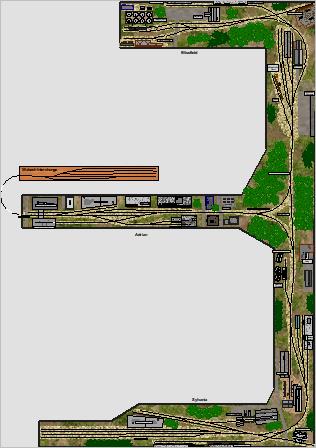 |
| Unionville | 10 x 11 | Unionville, as its name implies, sits astride a major interchange with the NYC lines. As a junction point, it receives a good amount of traffic and will forward many cars on their journey via this same manner. The small city of Unionville has one large grain mill and an assortment of light manufacturing businesses within its city limits. The trackwork is tricky and you will need to do a couple of switchback moves to reach many of your customers in Unionville |
 |
| UP - Reno Sub | 14 x 26 | This former double decked layout depicts UP branch service running from Reno Nevada, up through the northern quadrant of that state. This point-to-point plan is set in the modern era. There are 3 towns depicted - Winnemucca, Elko and Carlin, each of which has a small yard facility and a GP9 engine to service each town's industries. There is an ore processor and a high grade coal mine in the area which are serviced regularly by an Mine Turn job out of Reno. As well, there is an early morning Express run which drops new blocks of cars and picks up blocks of cars at each small yard which will be returned to the main yards in Reno. |
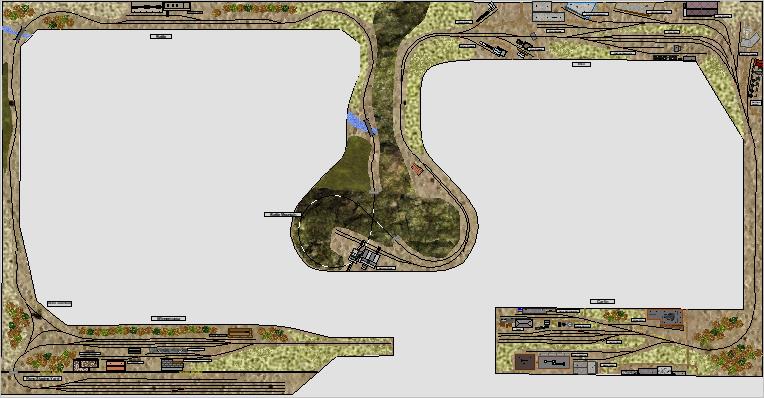 |
| Vernon Ave - Vernon CA | 11 x 33 | This would be a room sized layout based on switching tasks which play out daily on the Los Angeles Junction [LAJ] which is a bridge short line RR linking the BNSF and the UP at Vernon CA. LAJ has two yards simply named A and B Yards. This plan is based on a portion of A Yard which is where cars bound for local industries off Vernon Ave. are sorted and put into the correct blocks by the yard goats. This is a tough simulation to master but the crews on the LAJ deal with it every day! |
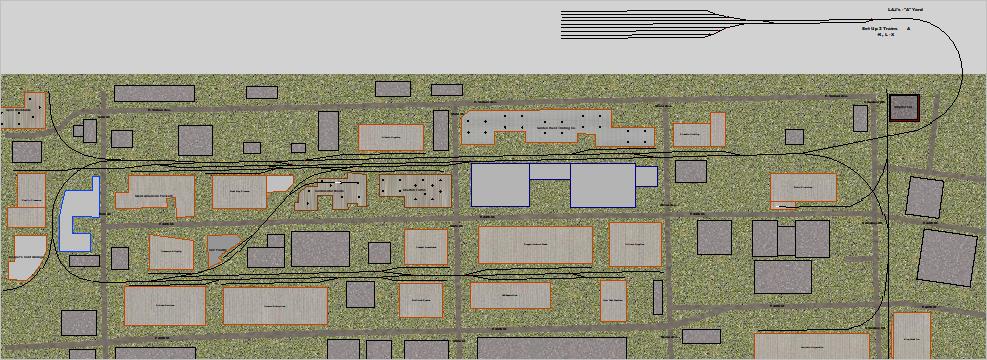 |
Visalia Electric RR 1952 |
19 x 20 | The Visalia Electric Railroad, a wholly owned subsidiary of the Southern Pacific Railroad (SP), began as an electric interurban railroad in Tulare County, in California in April 1904. It existed primarily to provide freight services for the fertile agricultural San Joaquin Valley. Passenger service was discontinued in 1924, and the electrification was removed in 1944. Subsequent operation was by diesel locomotive. In the 1960s, Southern Pacific lost interest in meeting the service schedules required for perishable fruits and produce, and with the retirement of their aging refrigerator car fleet, they brought an end to operations on the VER in 1992. On this plan, the motive power is a couple of 44 ton diesels which would have handled up to 2,300 car loads of navel oranges, lemon and other produce every annual fall harvest. |
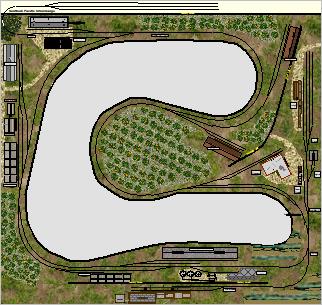 |
| Vista Verde | 14 x 15 | This room sized layout with a peninsula is based on Lance Mindheim's Waterfront plan. The layout features several typical dockside and nearby light industries. Incoming cars enter the scene from either the staging yard to the north or via the CSX interchange yard to the south. |
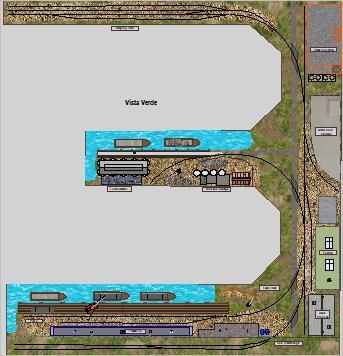 |
| Waite Business Park | 22 x 26 | Waite Business Park represents a modern commercial, industrial estate setting in the US north east with a transload centre, a couple of grain mills, and several medium sized rail-served industries. The Carson Yard looks to be very close, but it is actually miles away. But to achieve some realistic operations activities we have compressed the scene accordingly. Generous run-around tracks are provided to assist your switching of industries |
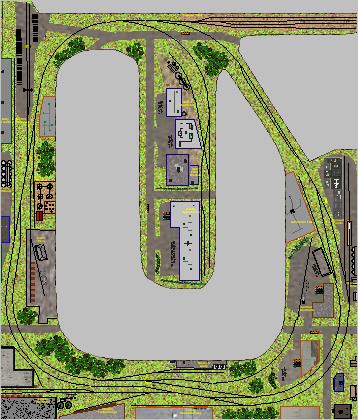 |
| Walkerville Southern | 19 x 22 | The Walkerville Southern is a fictional shortline operating in southern Pennsylvania in the late 1980s era. The WSRR services a few industrial mills, a lime producer, a fertilizer plant and some other light industries. It has a twice daily interchange with the Norfolk Southern RR. Their stated mission is to provide fast dependable service for their customers while keeping their costs to a minimum. That means they have few staff, only 2 engines and they are keen to move traffic to the NS Interchange as quickly as possible. |
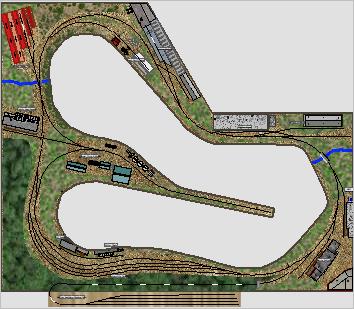 |
| Walnut Grove | 21 x 62 | Walnut Grove is a fictional community in the north west area of California in the late 1890s. As you might imagine, it is largely an agrarian based economy still - grain, feed, produce and cattle businesses abound. But there are some small industrial firms as well. Steam is king of the "iron" on this short branch line. |
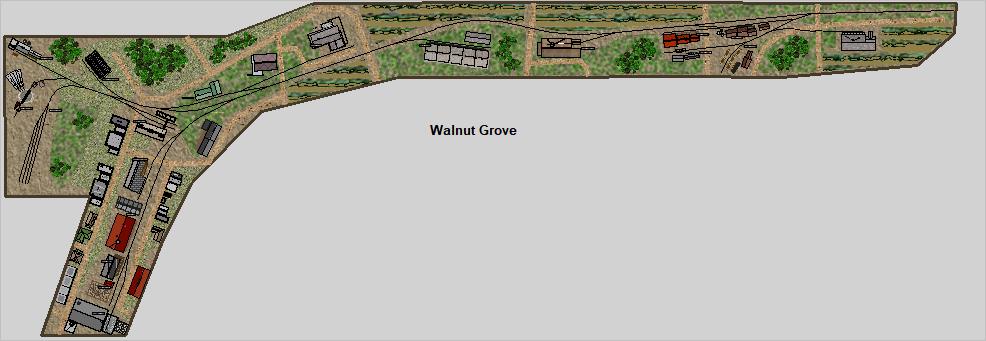 |
| Waverley Industrial Zone | 20 x 23 | This room sized layout is inspired by the designs of Lance Mindheim [http://lancemindheim.com/] and his interest in switching operations around modern day Miami, FL. Lance always includes plenty of "local color" and prototypical switching moves in his plans. We hope we have achieved those goals with Waverley Industrial Zone. |
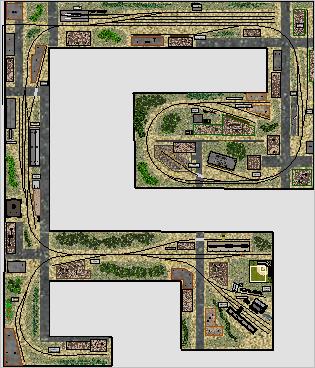 |
| West Quay | 12 x 34 | West Quay is a fictional port town in the west of England in the early 20th century era. It is the port access for the larger town of Fenstral. West Quay's industries mainly serve the fishing community with a fish factory and also hauling fish products to markets in the larger cities. There are some small service industries for moving cattle, coal and general goods to market. Fenstral also serves the general needs of the surrounding community which is dependent upon transport of coal, cattle, general goods and dairy products. There is also a local country passenger / parcel service into town. Just west of Fenstral is Claymore Works which is a major employer in this area since it produces a vast amount of clay pots, clay tiles and bricks. |
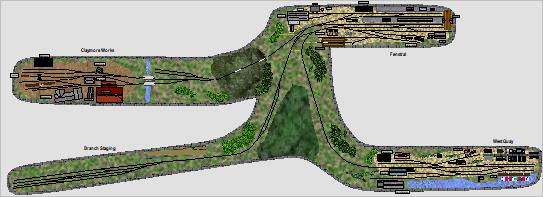 |
| Western Region Connecting RR | 14 x 16 | Southern Tier Connection RR - revised by Mark Johnson Quite probably you recognize the Southern Tier Connection RR beneath all the doodads. If not, you may view the original at Layouts/Standard/User in the Layouts Chooser. This layout ranks right up there in the top ten of my all time favorites and has been carefully modified for your enjoyment. The yard has been given greater capacity, the engine facilities reconfigured for better operations, the access hatch filled in to add a couple industries and all the track redrawn replacing the #4 switches with #6's. Operations have been set up to cycle through the five road loco's provided so you'll want to begin your session by bringing the specified loco from the roundhouse and spotting it on the outbound loco track between the turntable and the crossover. Keep the crossover clear as you may need to have it available. At this point, use the yard switcher to build your train. If there are any moves involving locations RS or ES, have the switcher perform those now. Once your train is assembled and the caboose is tacked on, retire the switcher, bring out the road loco, hook on to your train and take it for a drive. There are a number of possible routes around the layout and if you find the right one you'll be able to serve all the locations without having to perform any runaround moves. There are a couple routes that will result in turning the train around running the opposite direction around the layout. Be careful of those because you will be unable to get turned back around the other way. When you've made all the setouts and pickups, bring your train back and put it on the arrival track. Cut off the road loco and spot it at the ash pit. Use the yard switcher to put the cars in the yard and retire the caboose to the caboose track. |
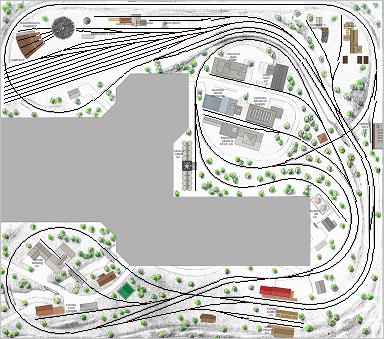 |
| Westvale Yorkton branch | 9 x 10 | The Westvale - Yorkton branch is based in the US north east in the 1920s era. It is a 3 foot narrow gauge line. The two towns on the branch generate a decent amount of traffic and together with the volume from the Ore mine, there is enough revenue generated to keep the rails in good repair and shiny. There is limited passenger traffic on the branch in this time frame and usually a coach / combine is added to an existing drag to form a mixed train to handle this demand. |
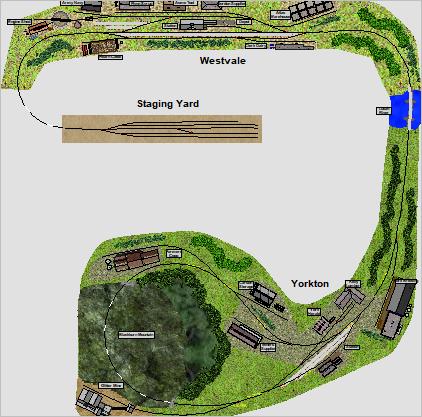 |
| Woody Glen | 6 x 62 | This is a fictional layout in north eastern Maine and, as its name implies, the main industry is a pulp and paper mill. The wye junction splits Woody Glen into 2 sides - the factories to the east and the paper mill to the west. There are 2 switch back tracks which may cause some grief, but careful planning will pay big rewards. |
 |
| Working the Yard Limits | 6 x 26 | Working the Yard Limits is a room sized layout plan which is set in the 1920 - 1940 time frame. This plan is based on a design by Allen Kershaw of his LAJ's Horn Division in Vernon CA. The industries are typical of the time period - light manufacturing and food processing - and the rail traffic is made up a 40 foot boxcars, hoppers, flats, gondolas etc. The LAJ's B Yard eventually connected to the then Santa Fe RR to the west of this plan but all traffic outbound would have been sorted and forwarded from the B Yard. Likewise, inbound traffic always passed through either the A or B Yards for the LAJ depending upon the customers being served. The 2 customers with the highest traffic on this layout are Joslyn Steel and Federal Cold Storage which are serviced first each session. You will need to use the runaround track in the yard area to set up you train properly. |
 |
| Worsley Branch | 16 x 19 | The room sized,fictional Worsley Branch, which is set in the 1930s in the northeastern US, depicts a branch line operation off the Pennsylvania RR main line. The Worsley Branch has a link with the B&O RR and exchanges a good number of cars daily with it. Along the Branch,there are a few light and medium manufacturers, some produce suppliers, a dairy, and a lumber supplier. One of the main traffic generators is the Co-op Grain mill which send its loads to market via the B&O. There is also a gas turbine passenger train - the Arrow, which visits Worsley, Collins, Arnprior and Goshen on its daily run. |
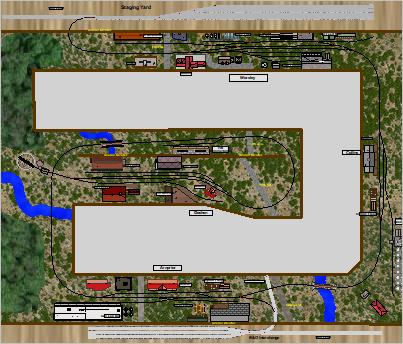 |
| Yancy | 16 x 29 | Yancy is a fictional 3 foot narrow gauge branch line of the Colorado Southern Railroad which operated from 1898 - 1908 as a Class 1 railroad when it was absorbed into the CBQ railroad and much later, into the BN empire. At the turn of the previous century, the CS was enjoying modest success moving freight over the hill country from north west Texas, through New Mexico, Colorado and up to Wyoming. |
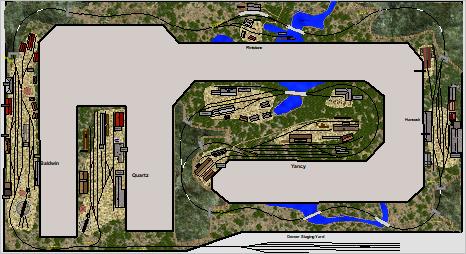 |
| Yuma | 29 x 29 | Yuma is a fictional 3 foot narrow gauge branch line of the Colorado Southern Railroad which operated from 1898 - 1908 as a Class 1 railroad when it was absorbed into the CBQ railroad and much later, into the BN empire. At the turn of the previous century, the CS was enjoying modest success moving freight over the hill country from north west Texas, through New Mexico, Colorado and up to Wyoming. Also, this is a virtual duplicate of the Yancy layout plan for the most part. |
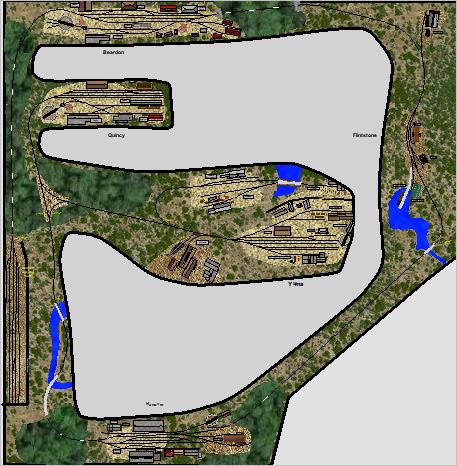 |